
The Westview School Blog
Progress, Not Perfection: Understanding Growth in Neurodivergent Learners

When Ceara Wainright-Herod, Upper School Principal at The Westview School, addressed parents at a recent Westview EDU, she began with a simple question: What does progress really mean?
The answer, she suggested, has little to do with report cards. With nearly two decades of public education experience, Herod has worked with students across the autism spectrum, neurodivergent and neurotypical learners alike. One message, she says, has remained constant: growth differs for every child and rarely follows a straight line. Her Westview EDU session, "Progress, Not Perfection: Understanding Growth in Neurodivergent Learners," directly challenged the common belief that progress is only about grades, reinforcing that growth at Westview is about the whole child.
Beyond the Report Card
“Dictionary.com defines progress as growth and development, continuous improvement, a movement toward a goal,” Herod said. “Nowhere in that definition do you see the word ‘grades.’ Nowhere does it say ‘academics.’”
For many parents, grades carry enormous weight. A low test score can cause worry; a good report card offers reassurance. Herod believes equating grades with progress overlooks how children, especially neurodivergent ones, develop.
“There are so many skills your child is building that don’t show up on a report card,” she said. “Independence. Confidence. Curiosity. Emotional regulation. Problem-solving. Those are real gains. They deserve celebration.”
The Myth of the Straight Line
One important part of Herod’s message was the reminder that no child grows in a straight, predictable trajectory.
“Growth includes plateaus, regressions, and spurts,” she said. “That’s not a flaw, that’s development.”
She encouraged parents to recall their own school years: subjects that came naturally, years that were a struggle, moments when understanding clicked. Children experience the same uneven progression. Neurodivergent learners may show this more, but the pattern is universal.
“A single low grade isn’t the story,” she said. “It’s one data point in a much bigger picture.”
Three Lenses for Understanding Growth
Westview uses a holistic, strength-based model to understand student growth, which Herod believes offers a more accurate and compassionate view. The model includes three domains:
ACADEMIC GROWTH: This includes the traditional markers such as reading, writing, and math, as well as the quieter signs of learning: beginning an assignment independently, asking questions, showing persistence, and building comprehension over time.
“Academic growth isn’t just the score,” Herod said. “It’s effort, curiosity, and the willingness to try again.”
SOCIAL-EMOTIONAL GROWTH: This area encompasses emotional regulation, self-awareness, confidence, and peer relationships. For many neurodivergent learners, these skills take time to develop.
“When children don’t know something, we teach,” Herod emphasized. “That includes how to deal with frustration, how to express emotions, and how to calm their bodies and minds. These are learned skills.”
EXECUTIVE FUNCTIONING: Organizing materials, managing transitions, following routines, and using coping tools are key here.
Herod recalled watching Westview Middle School students confidently open their lockers this morning, something that had taken weeks of practice and patient guidance.
“It was incredible to witness,” she said. “Routine, structure, and repetition work. When students succeed, their pride is enormous.”
The Role of Discomfort in Growth
Herod repeatedly emphasized: growth is uncomfortable for children and adults.
She shared several quotes with the audience, including Brian Tracy’s well-known line, “Growth and comfort do not coexist.”
She explained that children resist new challenges not because they can't succeed, but because the discomfort can be overwhelming.
“Those big reactions you see? The protests, the tears? That’s fear,” she said. “They don’t yet have the words to say, ‘This scares me’ or ‘This is hard for me.’”
Parents can help their children manage discomfort by modeling coping strategies.
“Tell your kids, ‘I’m nervous about a meeting today, so I’m taking deep breaths,’” she suggested. “Show them what managing big feelings looks like. That vulnerability is powerful.”
Rethinking Assessment
Twice a year, Westview uses standardized MAP Growth assessments to gather academic data, but Herod urged parents not to put too much weight on the scores.
“These tests aren’t designed specifically for neurodivergent learners,” she explained. “Some students sit through 45 questions in one session. If they’ve had a tough morning, if they’re distracted, if they’re overwhelmed, that score isn’t representative of their true understanding.”
Instead, the school emphasizes teacher observations, student reflections, and classroom work samples for a complete picture of progress.
“Tests matter,” she said, “but they don’t define your child.”
A Partnership Between Home and School
Herod stressed the importance of partnership: parents know their children best, and teachers see them in structured settings. Together, families and educators provide continuity that helps students thrive.
She encouraged parents to share what works at home, ask questions during conferences, and communicate openly with teachers about concerns.
"We are a village," she said. “Your insight helps us support your child, and ours helps you support them at home. Working together, students make meaningful progress.”
A Final Story
Herod ended with a personal story. At four, she struggled with separation, sensory overwhelm, and fear, crying daily at her first school as staff grew frustrated.
“I wasn’t dramatic. I wasn’t a troublemaker. I was anxious,” she said. Her mother moved her to another school where she felt safe and welcomed. She never cried again.
"I share that to show what safety and belonging can do for a child," she said. “That's what we want for your children at Westview: a place where they feel loved, supported, and celebrated on all days.”
The Message Parents Took Home
By the end of the session, one message stood out: progress is not about achieving perfection, but about each child's unique, steady growth at their own pace.
“Your children are not victims of their challenges,” Herod said. “They are victors. And every day, we see their victories.”
--
Ceara Wainwright-Herod, M.Ed. is the Upper School Principal at The Westview School. She has over 18 years of experience in public education, having served as a teacher, specialist, and assistant principal in public school system. Her work is grounded in student-centered learning and inclusive leadership. Ceara holds a master’s in Educational Leadership from the University of Houston–Victoria and has extensive experience supporting students across the autism spectrum and has collaborated with families and specialists to design individualized plans that meet each learner’s needs.
This blog post was adapted from the presentation given during WestviewEDU on Thursday, November 13, 2025. WestviewEDU is an education series presented by The Westview School for parents and caregivers of children with autism. For a complete list of WestviewEDU sessions remaining for the 2025-2026 academic calendar year, visit The Westview School online.
Cooking Up Connections: The Magic of Family Time in the Kitchen
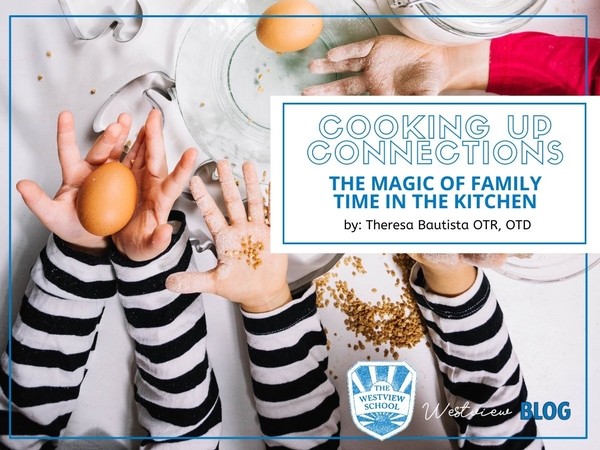
Parents are often looking for recommendations for fun family activities that could enrich their child’s life. Often, the best options can be found right at home.
Have you ever thought about involving your child in the kitchen? Activities such as preparing dinner, making a snack, or trying out a new recipe together can be a great start!
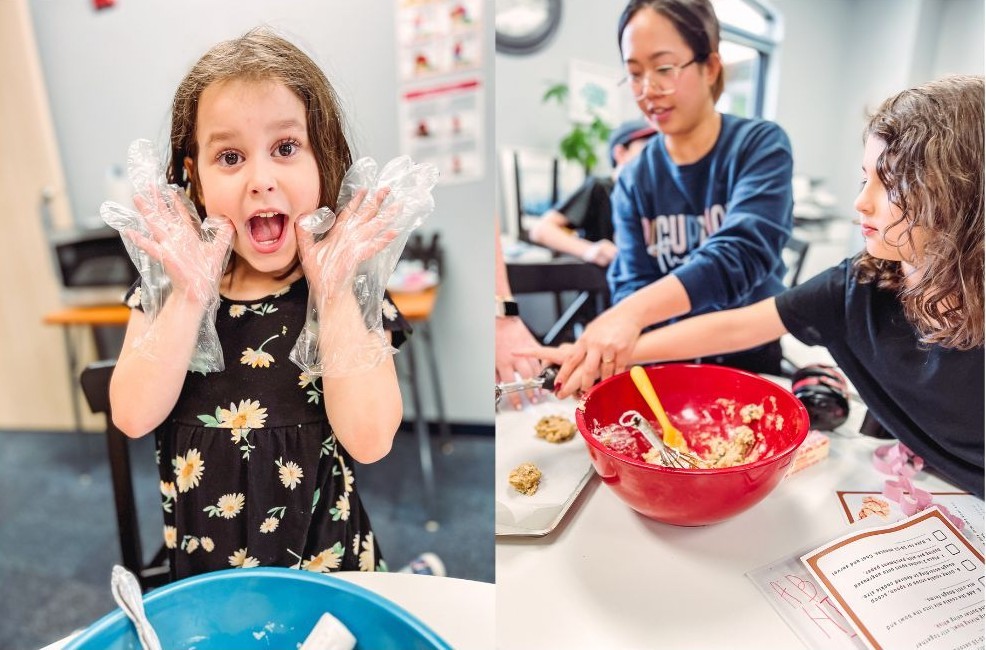
Cooking Skills and MORE
We all know that cooking teaches essential skills like measuring ingredients, following the sequence of steps in a recipe, and using various kitchen tools and equipment. Cooking provides an opportunity for children to learn how to handle utensils, chop vegetables, and stir batter. However, cooking offers far more than just the ability for your child to prepare meals for themselves and the family.
The kitchen is also an excellent place for sensory exploration – touching sticky textures (like dough) and experiencing various temperatures. Children with sensitivities to touch, taste, and smell, including those often described as "picky eaters," can benefit from this exposure, provided it allows them to explore at their own pace. This multi-sensory experience can expand their palate or help accommodate their specific support needs. For example, they may discover that wearing gloves can help their ability to handle certain textures.
The kitchen is not just a place for culinary adventures, it's also a classroom for safety. It's a perfect setting to teach children about the importance of being aware of extreme temperatures, sharp objects, breakables, and heavy items.
If you have concerns about kitchen safety, rest assured that there are kid-friendly tools like knives and scissors, non-slip cutting boards, and step stools available. You can gradually introduce them to heated tools, based on your and your child’s comfort level. This is also a great opportunity to demonstrate how to safely use the oven, stove, or air fryer.
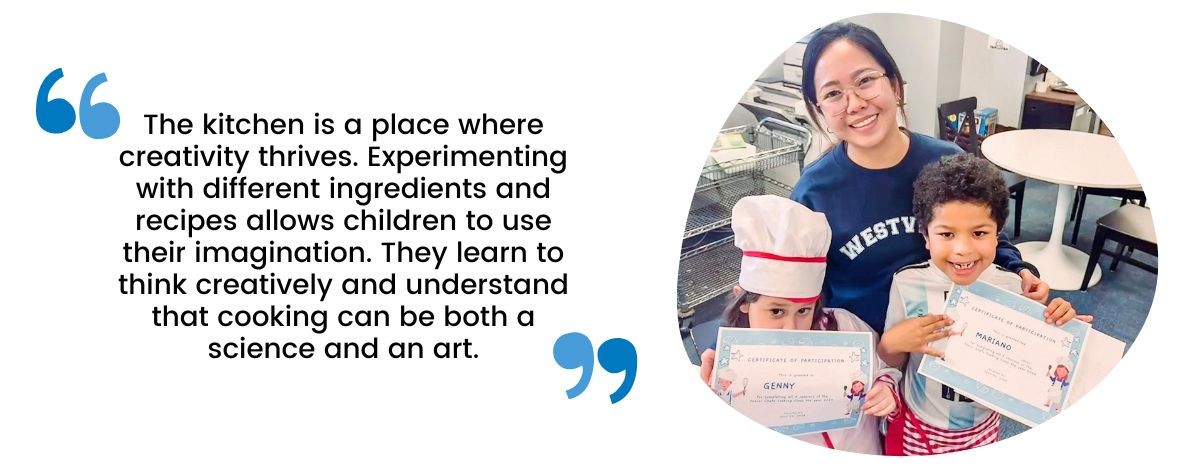
The Beauty of Cooking at Home
One of the best things about cooking with your kids in the kitchen is that you can make this a space for them to explore, make mistakes, and learn in a safe and familiar environment. When things get messy, spills happen, hands get sticky, or something breaks accidentally, allowing them to experience the natural consequences, teaches cause and effect. Initially, holding back immediate corrective feedback and allowing them to do it themselves allows them to learn and adjust. This approach builds their confidence and kitchen skills and reinforces your role as a trusted adult they can rely on for guidance.
These moments in the kitchen become cherished family stories, offering a chance to share the joy of creating something. Children witness firsthand how to communicate and how cooperation leads to a delicious end product. When families cook together, they learn to work as a team.
As children grow more comfortable in the kitchen, they gain independence. Learning to prepare meals for themselves is an essential life skill throughout their lifespan. The confidence they earn from these experiences extends beyond the kitchen and may contribute to overall self-esteem. If cooking is an accessible skill for your child, there are benefits to starting early and introducing them to the kitchen, especially if this is an area of interest.
By making cooking a shared family activity, you not only impart essential life skills to your children but also create a nurturing environment. So, roll up your sleeves, grab those aprons, and enjoy the many rewards of cooking together!
---
Theresa is a Registered Occupational Therapist with experience working with children, youth, and adults with neurological differences in the private school, clinic, and community settings. She received her Doctorate Degree in Occupational Therapy from The University of Texas Medical Branch at Galveston. Prior to becoming an occupational therapist, she worked in the field of Applied Behavior Analysis as a Registered Behavior Technician. She is also a writer and consultant who offers her specialized knowledge to websites and companies serving the neurodiverse community.
Visual Supports to Build Independence: Teacher Techniques That Transform Learning

At The Westview School, we believe that fostering independence is a cornerstone of helping children with autism thrive academically, socially, and emotionally. One of the most effective tools in this journey is the use of visual supports. Visual supports use images, symbols, or cues to help students process information, communicate clearly, and navigate their day. Some examples of this include picture schedules, checklists, social stories, timers, and task cards.
From managing daily routines to enhancing emotional regulation and problem-solving, visual supports empower students with confidence and autonomy. Westview teachers and administrators integrate these strategies into their classrooms every day. Each approach reflects the creativity and dedication of Westview staffers to ensure every student has the tools they need to succeed.
Morning Checklists: Starting the Day with Independence
Christine Reilly, Lower Elementary Teacher
Executive functioning skills, such as organization and time management, can be challenging for children with autism. Visual checklists provide a structured approach to these challenges. In Lower Elementary, students start their day with a visual checklist displayed on the board detailing morning expectations. For example, a picture of a backpack represents hanging it on a hook. As the year progresses, these picture prompts are gradually replaced with words, and eventually, students complete tasks independently without visual assistance.
"This approach not only creates a predictable environment but also reduces anxiety and fosters a sense of accomplishment," says Christine Reilly. "Students feel confident knowing they can take responsibility for their morning routine."
Transition Cues: Easing the Shift Between Activities
Trevie Stone, Lower School Physical Education Teacher
Transitions, particularly away from preferred activities, can be challenging for many students. Leaving the motor room can often be a tricky transition. Visual timers, such as the TimeTimer™, paired with verbal countdowns, help students understand the abstract concept of time.
"I might say, 'We have five minutes left. What would you like to do before we leave?'" explains Trevie Stone. "Picture cards are another helpful tool. A small picture of the next activity or location can be a tangible reminder, helping students anticipate what's next."
The physical setup of the environment also supports transitions. Designated line-up spots and shoe cubbies act as visual cues for students, creating a smooth and predictable flow from one activity to the next.
Innovative Visuals for Younger Students
Amanda Warley, Prekindergarten Teacher
In Prekindergarten, visuals are everywhere—on the walls, at tables, and in task instructions. Amanda Warley recently introduced a portable photo printer to create instant visual aids tailored to her students' needs. "If a student prefers blocks over trains, we can immediately update our visuals to reflect that," she shares.
Amanda also uses visuals to prepare students for new experiences. For example, before practicing for the holiday program in a different building, she printed a photo of the location. “Having a picture helps students process what to expect, reducing anxiety. These personalized visuals make all the difference in fostering understanding and comfort.”
Step-by-Step Task Cards: Building Independence in Learning
Serena Gaylor, Middle School Language Arts Teacher
Breaking down tasks into manageable steps fosters independence and encourages self-assessment. "In my classroom, students always have a 'to-do' list and an 'after I'm finished' list displayed on the screen," says Serena Gaylor.
Recently, during a poetry unit, students followed a criteria-based checklist to evaluate their work. "This allowed them to independently assess their poems, identify areas for improvement, and ask more specific questions," Serena explains. "Step-by-step guides give students the tools to take ownership of their learning and build confidence in their abilities."
Visual Supports for Emotional Regulation
Sally Schwartzel, Lower School Principal
Visual supports also play a vital role in helping students manage their emotions. Tools like visual schedules, checklists, and social narratives provide clarity and predictability, reducing anxiety. "When students know what to expect, they feel more in control of their day," says Sally Schwartzel.
For emotional regulation, visuals can help students identify their feelings and choose appropriate coping strategies. “If a student feels frustrated, visual supports remind them of what they can do—like taking deep breaths or asking for help. This empowers them to navigate challenging moments with greater confidence.”
Empowering Students Through Visual Supports
Visual supports are more than tools; they are bridges to independence, confidence, and self-advocacy. At The Westview School, we take pride in using evidence-based practices to meet our students' unique needs. By integrating creative and personalized strategies, our educators ensure that every child can shine in their own way.
Want to see these approaches in action? Visit our website or connect with us on Instagram and Facebook to learn more about how we are empowering our students every day.
Making a Language Connection: Gestalt Language Processing in Autism
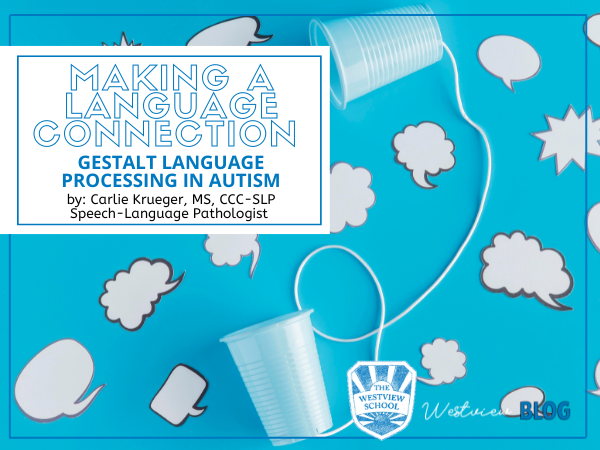
Language is a foundational tool for human connection, but how it's acquired and processed can vary greatly. For individuals on the autism spectrum, language development can sometimes follow a distinctive route called Gestalt Language Processing (GLP). One of the key features of GLP is echolalia—repeating phrases or language chunks they've previously heard. This behavior, sometimes misunderstood as meaningless repetition, actually plays a significant role in language learning. Understanding the nuances of GLP and echolalia can open up new ways to support those with unique communication needs.
What is Gestalt Language Processing?
Gestalt Language Processing is a way of learning and using language where individuals process larger language segments, such as phrases or sentences, rather than focusing on individual words. This approach is grounded in Gestalt psychology, which suggests that our minds perceive things as whole units rather than isolated pieces. For many neurotypical children, language starts with single words and gradually builds into more complex sentences. In contrast, Gestalt language processors often begin by learning language in chunks—phrases they've heard in TV shows, songs, or daily conversations. These segments are memorized and repeated verbatim as the initial step in their language journey. Over time, they learn to break down these chunks and use them flexibly to create novel sentences.
The Role of Echolalia in Gestalt Language Processing
Echolalia, the repetition of previously heard words, phrases, or sounds, is often observed in early GLP language stages, particularly among autistic individuals. There are two primary forms of echolalia: immediate and delayed. Immediate echolalia involves the instant repetition of recently heard phrases, often as a way of processing language or mirroring the emotions conveyed in the interaction. For instance, if someone asks, "Do you want to go outside?" an individual might respond by repeating, "Do you want to go outside?" instead of directly answering. Delayed echolalia, on the other hand, occurs when phrases heard in the past—sometimes days or weeks earlier—are recalled and repeated. This is commonly referred to as scripting. These phrases might stem from movies, TV shows, or previous conversations and can be used to express emotions or communicate specific needs. For example, a child feeling overwhelmed might say, "Let it go!" echoing a familiar Disney lyric to signal their need for a break.
Echolalia as a Key Part of Language Development
Contrary to being a random or meaningless behavior, echolalia is essential to language development within GLP. Instead of focusing on single words, individuals initially store entire phrases as building blocks for language. Through repetition, they start to understand social cues and language patterns. Eventually, they begin to manipulate these stored phrases, breaking them down into individual words and allowing them to construct unique sentences.
Echolalia serves several roles: it helps individuals learn the rhythm and structure of language, allows them to express emotions and experiences that resonate deeply, and sets the foundation for more flexible, self-generated language. For example, a child who frequently says, "It's time to go to bed," might eventually repurpose the word "bed" in new sentences, like "I want my bed," demonstrating growing independence in their language use.
The Connection to Autism: Why Autistic Individuals Often Use Echolalia
Echolalia is especially common among autistic individuals, who frequently use it as a primary method of communication early on. There are several reasons for this. Autistic learners often have an exceptional ability to recognize patterns, and language chunks can serve as familiar patterns they can recall and apply in specific contexts. Additionally, many autistic individuals experience heightened sensory awareness, which may cause them to focus on the tonal and rhythmic aspects of language over individual words. This focus on auditory "wholes" makes echolalia an effective tool for processing language patterns.
Socially, echolalia can bridge the gap between an autistic individual's inner world and the expectations of the social world. By repeating phrases they've heard, they are engaging with language in a way that allows them to participate in social interactions, even if it doesn't follow traditional conversational norms.
Supporting Echolalia and Language Development
When viewed through the lens of GLP, echolalia is not a behavior that needs "correction" but rather a meaningful stage in language development. For those who work with or care for individuals using echolalia, there are several ways to support their language journey.
Acknowledging echolalia as a valid form of communication is essential. Rather than dismissing repeated phrases as meaningless, it's helpful to consider them within the context of the individual's emotions, needs, or attempts to participate in conversations. Providing varied, emotionally engaging language experiences can enrich the language they're absorbing and increase the variety of phrases they can use over time. Patience is key in supporting their language development; each individual progresses at their own pace, and allowing them the freedom to navigate language in a way that feels natural to them is crucial.
Conclusion
Gestalt Language Processing provides an invaluable perspective on how some autistic individuals develop language, highlighting the significance of echolalia as a natural part of that process. For those who process language gestaltically, echolalia is a bridge from memorized phrases to flexible, self-generated language, where each stage supports the next.
Understanding GLP and the role of echolalia allows us to see language development as a spectrum of unique pathways, each worth supporting and celebrating. Embracing this approach not only provides effective support but also empowers individuals to communicate in ways that feel authentic to them, fostering genuine connection and self-expression.
References
Blanc, M. (2012). Natural language acquisition on the autism spectrum: The journey from echolalia to self-generated language. Communication Development Center, Inc.
Peters, A. (1983, 2021). The units of language acquisition. Cambridge University Press.
Prizant, B. (1982). Gestalt language and gestalt processing in autism. Topics in Language Disorders, 3(1), 16-23.
Carlie Krueger, MS, CCC-SLP is a Speech-Language Pathologist at The Stewart Center at The Westview School. She graduated Summa Cum Laude from Utah State University with a B.S. in Communicative Disorders and Deaf Education and obtained her M.S. in Communication Sciences and Disorders from New York University. She strives to practice within a neurodiversity-affirming framework that centers self-advocacy and authenticity for her clients. Carlie has been working full-time as an SLP at The Stewart Center at The Westview School since 2022. If you or your family are interested in learning more about the services The Stewart Center provides, visit us online at The Stewart Center.
From Tantrums to Triumphs: Behavior Strategies at Home and Beyond

Understanding behavior, whether at home or in the community, can feel overwhelming, but it all boils down to one simple fact: behavior is just any measurable action. In this blog post, Sally Schwartzel, Lower School Principal at The Westview School, shares practical strategies for managing behavior by focusing on what we can control—our own actions. From offering choices to teaching replacement behaviors, these insights help parents create more positive interactions with their children. This post was adapted from her presentation for September WestviewEDU.
Behavior: It Is What It Is
When thinking about behavior in the home and community, there are many topics to cover – everything from self-help skills to attending a group function with peers. However, this wide range of topics can all be addressed by looking at behavior for what it is. It’s just behavior! Behavior is any measurable, observable action. Behavior is anything from waving hello to someone to hitting a friend.
The most important thing to remember is that we cannot change the behavior of others. This can be SUPER frustrating! BUT, there are things that we can change. Changing what we are doing, in turn, will change the behaviors of others. To figure out what to do before or after, we need to know “Why” the behavior is occurring. The “Why” is also called the “function” of the behavior. Don’t worry – there are only two main reasons why behaviors occur. PSA: This applies to all people, not just our kids. All of us exhibit behaviors (positive or negative) because we obtain or escape something. Many times, we work for a paycheck (obtain). We also push the snooze button on an alarm – to escape the noise… and the waking up part! To change behavior, we have to change what happens before or after it happens – which is something we can control.
Changing the Before and After
So, what can we do before a behavior happens to prevent it? My favorite is offering a choice – with a catch. The choice isn’t “Are you ready to do your homework?” The choice is “Do you want to do your homework now? Or do you want to do your homework in 5 minutes?” This gives the option to make that choice - but within your parameters. My second biggest recommendation is to frontload expectations. Give your kids a visual schedule or a checklist. Set up a routine. The more our kids know what to expect, the fewer surprises for everyone involved! Think about what a “to-do” list does for you... the schedule/checklist is their “to-do” list!
What about after a behavior occurs? If a person is still exhibiting a behavior, they are either obtaining or escaping something. For example, if a child throws a tantrum in line at the grocery for a candy bar and gets a candy bar, next time, it’s really likely that the child will throw a tantrum again. If a child rips up their homework and doesn’t have to complete it, it will likely get ripped up again. To break that pattern, we need to change what happens after. We can power through the line at the grocery store with the child kicking and screaming. We could have extra copies of the homework or ask for a laminated copy that can’t be ripped. Seems easy enough, right? WRONG. Sometimes, the tantrum in the line in the grocery store is too big. Sometimes, the ripping of homework after a long day is the final straw at the end of a really long day. The missing piece is teaching our kids what to do instead of the challenging behavior.
Teaching Replacement Behaviors
The “what to do instead” is called a replacement behavior. Replacement behaviors get our kids what they want (or don’t want) in a more appropriate way. If we set the expectation at the grocery store as “If you do not throw a tantrum and you ask for a candy bar,” you will get it. If, during homework time, the expectation is that the child can ask for a break or ask for help, that is a much better behavior than ripping it up.
You’re probably thinking, “So I have to let my child get a candy bar every time? Or let them not do their homework?” The answer is… well, kind of. This is only in the beginning while you are teaching those replacement behaviors. Once the child learns they do not need to exhibit those inappropriate behaviors, you can start taking steps back or fading support. For example, the new expectation is “If you do not _____, you can get a snack this time in the line and a candy bar next time.” The expectation can be set at the beginning of the grocery store trip that a candy bar isn’t an option this time, but these three different yummy snacks can be asked for. When it comes to homework, maybe the child needs to write their name on the homework before asking for a break. If the child learns to ask for help, maybe you give them the answer to the first part and then have them complete the rest on their own.
Simple Long-Term Tips for Success
Behavior is so easy and so complicated at the same time. The best advice I can give (learning from different parents throughout the years) is to do what you must to keep your sanity. Tip for doing that and still working behavior to your advantage? Having your child comply with the tiniest directive before giving them a preferred item or activity will save your life in the future. I have had some parents, in order to keep their sanity, have their child simply push in a chair, clear a dish, etc. before iPad time. It seems so small, but it will really help out in the future!
Sally Schwartzel is the Lower School Principal at The Westview School. She brings a wealth of knowledge and experience to The Westview School, having worked for over 18 years in Katy ISD as a special education teacher in specialized autism programs and then as a leader at the district level for autism and behavioral programming. She holds a Master’s Degree in Special Education with a focus on Autism and Developmental Disabilities from The University of Texas. She is a Certified Teacher and a Board Certified Behavior Analyst. She has co-authored and co-presented on relevant topics such as Positive Behavior Interventions and Supports and Autism Support and Intervention Program.
This blog post was adapted from the presentation given during WestviewEDU on Thursday, September 5, 2024. WestviewEDU is an education series presented by The Westview School for parents and caregivers of children with autism spectrum disorder. For a full list of WestviewEDU sessions for the 2024/2025 academic calendar year, visit The Westview School online.
Executive Functioning: Air Traffic Control for Your Brain!
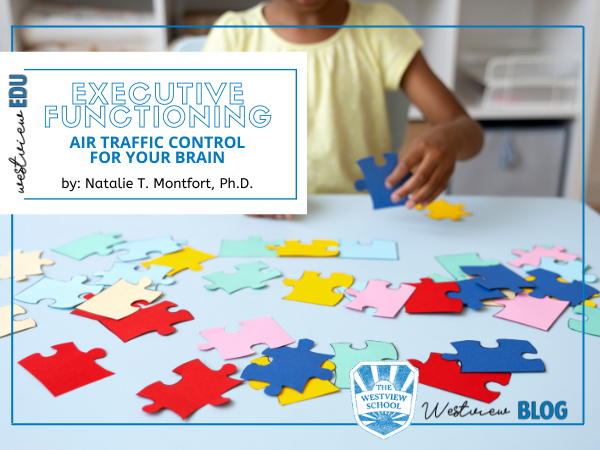
Do you know people in your home or classroom who always lose their belongings, forget important items, get lost from the kitchen to the bedroom, run chronically late, or just generally seem like a "mess?" Weak executive functioning could be to blame!
Executive functioning is a general term that refers to our mind’s mental manager or the cognitive processes that regulate our thinking and behavior. While there are many models of executive functioning, most include the individual’s ability to generate ideas, initiate or begin a task, stick to and finish a task, flexibly problem-solve, shift from one idea or topic to another, inhibit our impulses, ignore distractions, regulate attention, regulate our behavioral and emotional responses, use feedback to guide future behavior, select relevant goals, organize materials, hold information in mind until needed, and more. I like to think of our executive functions as air-traffic control for our brain or as the conductor of the mind’s orchestra.
When all is well, cognitive processes flow smoothly, and behavior fits the situation as expected. When there are problems… well, just imagine the airport with poor air-traffic control! Executive functioning is needed for all aspects of life. Socially, we need executive functioning to help us regulate our behavior and emotions when we are upset. After all, throwing the board game when we are losing is frowned upon…, particularly in adolescence or adulthood! We spend a great portion of time controlling our impulses to speak out in school or a meeting, to refrain from spending too much money, or even overeating. Executive functions help us to arrive on time, prepared, and with a plan for how to behave. They are also critically important for academic success. Not only are executive functions needed for decoding written text, reading comprehension, solving math word problems, and long division, but they are also needed to be an organized, efficient student who remembers homework and can plan for projects and tests. These days, if you are not in the right place, with the right things, at the right time, it is difficult to be a good student, no matter how bright you are! In fact, being in the right place, with the right things, at the right time is the very basis of holding a job.
When there is executive disfunctioning, life may feel chaotic or unproductive. The child or adult may experience social, academic, or employment difficulties and/or problems in the home. The good news is that executive functions are thought to be able to be developed or strengthened. These skills begin developing in infancy as babies learn to wait to have their needs met. They really come ‘on board’ in the brain around age two as children learn they are active agents in their own world. Beyond that age, executive functions are thought to keep developing into young adulthood. Just as they can be strengthened, executive functions can be weakened or damaged. Neurological insults from accidents, injuries, or other sources can impact executive functioning temporarily or long-term.
Executive dysfunction is often part of the presentation of neurodevelopmental disorders such as Attention-Deficit/Hyperactivity Disorder, Autism Spectrum Disorder, and Specific Learning Disabilities. Although executive functioning is thought to be the most impaired in the aforementioned conditions, it is also implicated in conditions such as anxiety, depression, and even medical conditions such as low blood sugar. Problems with executive functioning are often what bring families to seek help from psychologists, psychiatrists, or doctors.
Understanding the importance of executive functioning is the first step to facilitating its development. The ‘Practice Makes Perfect’ principle applies here. If a child has no experience planning for their day or organizing their materials, it is unlikely that he or she will simply arrive at this skill in high school.
From the time they are small, children should be encouraged to help with planning and organizing. A toddler may not be able to make a sandwich, but they can help pack a lunch. Likewise, a young child who cannot do their own laundry can sort laundry or help pick out clean clothes for tomorrow.
Children can also help with the planning and preparation for parties, events, and projects. Learning how to react when what we want is not available, what to do when we forget something important, and how to persist with the temptation of distractions are all valuable skills that adults need to afford children. Children can have fun while they help adults with household tasks and learn these skills. They can also work on these skills in their play.
Childhood games have been shown to improve the executive skills of preschool children. Games such as Simon Says, Red Light Green Light, and Mother May I all help children to practice attending, inhibiting impulses, problem-solving, regulating behavior, and regulating emotions. For older children, yard games such as Freeze Tag and Capture the Flag can be helpful. Board games are also great ways to develop flexibility, inhibition, problem-solving, and shifting. Some favorites for young children are Candy Land and Chutes and Ladders. These games are great for teaching flexible thinking by changing the rules. Some fun examples are to play the board backward or try to be the last one to cross the finish line! For older children, strategy games such as chess, Chinese checkers, or Risk may be helpful. Children and adults also tend to enjoy German-style or Euro board games. These games tend to minimize conflict and luck and emphasize problem-solving strategies. Some popular examples are Ticket to Ride, Settlers of Catan, Small World, and Dominion. These games require planning, problem-solving, shifting strategies, and many other executive functions to master despite relatively easy gameplay and moderate playing times.
In addition to practicing executive functioning skills throughout life, accommodations and supports for weak executive functioning are often helpful. For example, making lists, using sticky-note reminders, using alarms, and having organizational systems in place can help support executive functioning skills. There are several books available with excellent strategies for support. Some of my favorites are: Smart but Scattered: The Revolutionary “Executive Skills” Approach to Helping Kids Reach Their Potential by Peg Dawson and Richard Guare; The Explosive Child: A New Approach for Understanding and Parenting Easily Frustrated, Chronically Inflexible Children by Ross Greene, PhD; and The Asperkid’s Launch Pad: Home Design to Empower Everyday Superheroes by Jennifer Cook O'Toole.
Executive functioning skills take effort and experience to develop over time. Many services and providers exist for families requiring guidance to facilitate growth in their loved one’s executive functioning. The Stewart Center at The Westview School offers individual therapy to facilitate executive functioning in adolescents and adults, group therapy for fun skill-building in children, as well as parent coaching and case management to assist families in promoting these skills in their daily lives at home. For more information, contact 713-973-1842 or info@stewartcenterhouston.org.
--
Dr. Natalie Montfort is a licensed clinical psychologist with Montfort Psychology Associates. Dr. Montfort has over 20 years of experience working with children and adults with ASD and has training in Cognitive Behavioral Therapy (with children, adolescents, and adults), Trauma-Focused Cognitive Behavioral Therapy, Relationship Development Intervention, Social Thinking, behavior modification (including Applied Behavior Analysis), and education/educational assessment. Dr. Montfort graduated summa cum laude and as valedictorian of the College of Liberal Arts and Sciences at the University of Houston with a Bachelor of Science Degree in Psychology. She earned a Master of Arts Degree and a Doctor of Philosophy Degree in Clinical Psychology from Fielding Graduate University. Dr. Montfort completed her doctoral internship with the University of Texas Health Science Center at Houston’s Department of Psychiatry and Behavioral Sciences and her post-doctoral fellowship at The Stewart Center at The Westview School. She obtained licensure as a Clinical Psychologist in 2016, and she and Dr. Ken Montfort launched Montfort Psychology Associates in 2020. Her areas of interest include assessment of children, adolescents, and adults; cognitive and behavioral differences in children with neurodevelopmental disorders; treatment of adoption-related issues; treatment of childhood trauma; and animal-assisted therapy. She also enjoys providing professional development, trainings, and lectures on these and other topics to a wide variety of audiences.
This blog post was adapted from the presentation given during WestviewEDU on Thursday, September 1, 2022. WestviewEDU is an education series presented by The Westview School for parents and caregivers of children with autism spectrum disorder. For a full list of WestviewEDU sessions for 2022/2023 academic calendar year, visit The Westview School online.
A Parent's Guide to Managing Therapy for Kids with ASD
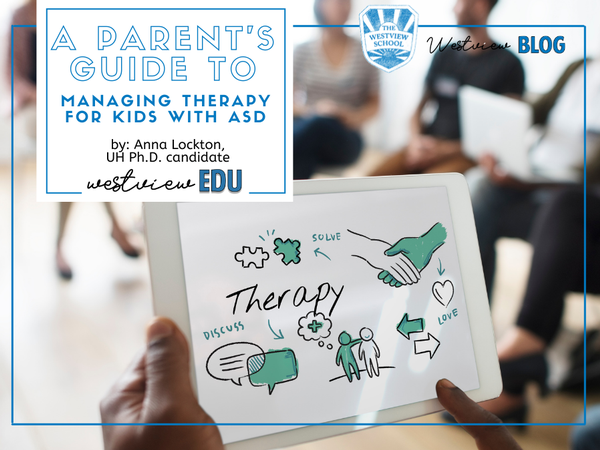
There are many factors to consider when determining interventions and support for children with autism spectrum disorders (ASD). What works best? How often should we go? How many hours do we devote to this? What behavior or symptom do we target? Who provides this service? The list of questions is lengthy and can feel overwhelming. Here is a concise list of things to take in consideration as we determine the best supports for our children.
It Takes a Village
When it comes to therapy choices for your child, you don't have to make all these decisions on your own. One of the benefits of having multiple providers is that you can develop a treatment team. A treatment team is usually made up of the various providers working with your child. This may include their therapists, teachers, doctors, caregivers, and the individual themselves. Having a team of people on the same page regarding goals and treatment for your child helps immensely when deciding what approach to take, whether treatment is working, and what steps should be taken next.
No One Size Fits All
Because ASD is a heterogeneous disorder, it is challenging (if not impossible) to make blanket statements about what works best. We know from decades of research that behavioral interventions are often beneficial for individuals with ASD. Behavioral intervention is a broad category, though, and the delivery and duration of services may look quite different. When selecting an intervention, it is essential to remember that your provider should be able to explain why they are using a particular therapeutic approach with your child, what precisely they are targeting, and how data drives their decision-making.
When Needs Change, Therapies Should Too
When it comes to interventions or therapies and ASD, we often spend a lot of time talking about applied behavior analysis or ABA and social skills. But children often need other services like speech therapy, occupational therapy, and physical therapy. Sometimes we also need to develop skills to benefit from other interventions. For example, if our child has difficulty with behavior regulation or attending skills, they may not be ready for a group social skills program. We also tend to focus on early identification and intervention. Still, as children get older, priorities may change. There are other co-occurring conditions that families should be aware of, as these diagnoses may also require treatment or intervention. For example, many children and adolescents with ASD experience anxiety and/or depression. In this case, we may want to find a therapist with experience providing interventions like cognitive behavioral therapy (CBT) with modifications for ASD.
Ask an Expert About Medications
It is helpful to remember that sometimes individuals may need medication in addition to therapy. At this time, there are no FDA-approved medications that treat the core features of ASD. However, approved medications can address symptoms like irritability, anxiety, depression, hyperactivity, sleep, etc. Decisions about medication can be complex and multifaceted. Medication is something families can discuss with their child's treatment team. Having multiple sources of input can help inform families and prescribers on the effects of medication. And just like with other forms of treatment, baseline and ongoing data collection should be an important component of decision-making with medication.
In summary, there are many different approaches to treatment for children with ASD. As children get older, our approach to treatment may change better to meet the needs of the individual and their family. Treatment may need to address other mental and behavioral health issues and ASD. There is no absolute or set plan to follow for treatment or intervention for individuals with ASD. And because there are so many options and choices, making decisions can feel overwhelming. Focusing on treatments with solid evidence can help guide families during these times. Communication with your child's treatment team can also help facilitate decision-making.
--
Anna Laakman is currently a third-year doctoral student in School Psychology at the University of Houston. She is originally from Little Rock, Arkansas, but returned to Houston from Southern California, where she worked at the Center for Autism & Neurodevelopmental Disorders at the University of California-Irvine as the Education and Training Director. Her B.A. is in Communication and Sociology from Wake Forest University in North Carolina. She also holds a master's degree in Special Education with a focus in Autism Spectrum Disorders from the University of Missouri-Columbia. Her previous work experience includes work at the University of Missouri Thompson Center for Autism and Neurodevelopmental Disorders in diagnostic evaluations, research, and training and education. Additionally, Anna previously worked at Texas Children's Hospital on the Simons Variation in Individuals Project. Her current research interests are in camouflaging in ASD and the female phenotype of autism.
This blog post was adapted from the presentation given during WestviewEDU on Thursday, November 4, 2021. WestviewEDU is an education series presented by The Westview School for parents and caregivers of children with autism spectrum disorder. For a full list of WestviewEDU sessions for 2021/2022 academic calendar year, visit The Westview School online.
7 Ways to Use Therapeutic Strategies to Work with Your Child at Home
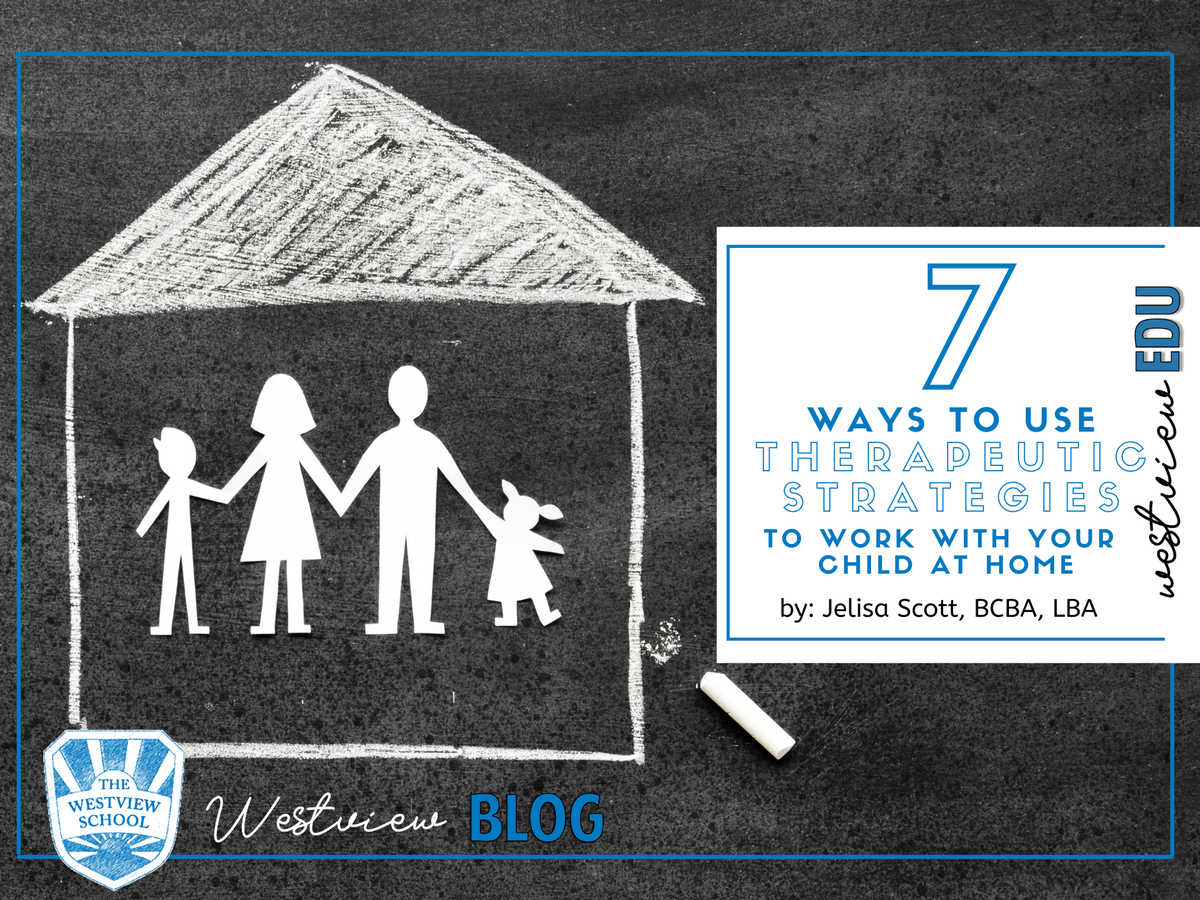
If you have a child on the autism spectrum, it is more than likely that therapy sessions play a part in your monthly calendar. The types of therapy that specifically benefit your child may differ. However, it has been proven that therapy for children with autism spectrum disorder is beneficial to improve behaviors that interfere with your child's ability to learn and support the development of skills needed for children to care for themselves independently. As a parent, you can use therapeutic strategies learned from professionals to help you work with your child at home.
This is not a post about what therapy will work best for your child but one that offers therapeutic strategies you can use to work with your child at home. However, it is essential to make sure the therapy of choice for your child is effective. The best quality therapies have documented evidence of replicated positive effects and don't rely heavily on personal testimonials. Most importantly, you should be receiving parent support from your child's therapist to learn about ways to improve or sustain your child's progress.
The best ways to apply skills that your child has learned in the home are to:
1. Create functional learning opportunities. For example, if your child is working on requesting things they need, set up situations that will help them functionally apply the skills they are learning. Give them a bowl with no spoon or an empty cup with no juice. This will create the opportunity to apply their newly learned skills.
2. Turn mistakes into learning opportunities. Help foster independence and application of problem-solving skills by helping your child find solutions to the mistakes that they have made.
3. Establish and follow through with boundaries and consequences. Be clear with your expectations and do exactly what you say you are going to do. If you say, "First we need to clean up, then we will go to the park," then you should only take them to the park IF they cleaned up first. When you don't follow through with the boundaries you set, you unintentionally teach your child that they don't need to follow your instructions.
4. Reinforce attempts at independence. Reinforcement is the only way to increase the likelihood of them engaging in that independent behavior in the future. Since we want our children to be as independent as they can, we must reinforce their attempts at being independent.
5. Include language used in therapy in the home (and vice versa). Using the language or phrases that your child commonly hears will help promote generalization across settings, like the home and their therapy clinic.
6. Adapt accommodations for home use and portability. Make sure that you can bring any accommodations (ex: visuals, communication devices, sensory tools, etc.) that help make your child successful into the home and community.
7. Evaluate and care for your personal well-being. You will not be able to apply all the previously described strategies without taking care of your own mental, physical, and emotional needs.
Putting these therapeutic strategies into practice at home is a great way to reinforce your child's work in the therapy setting.
--
Jelisa Scott is a Board Certified Behavior Analyst (BCBA) and a Licensed Behavior Analyst (LBA) in the state of Texas. She received her bachelor's in Psychology from Louisiana State University in 2010, her master’s degree in Behavior Analysis from the University of Houston Clear Lake in 2014 and is currently in school to earn her doctorate degree in School Psychology from the University of Houston. Jelisa has been working with children with and without special needs since 2008 and has gained experience providing in-home ABA services, parent training, classroom consultations, navigating ARD meetings, decreasing severe problem behavior, improving verbal behavior, social skills training, and early childhood intervention.
This blog post was adapted from the presentation given during WestviewEDU on Thursday, October 7, 2021. WestviewEDU is an education series presented by The Westview School for parents and caregivers of children with autism spectrum disorder. For a full list of WestviewEDU sessions for 2021/2022 academic calendar year, visit The Westview School online.
Put on Your Oxygen Mask First: 5 Self-Care Strategies for Autism Parents
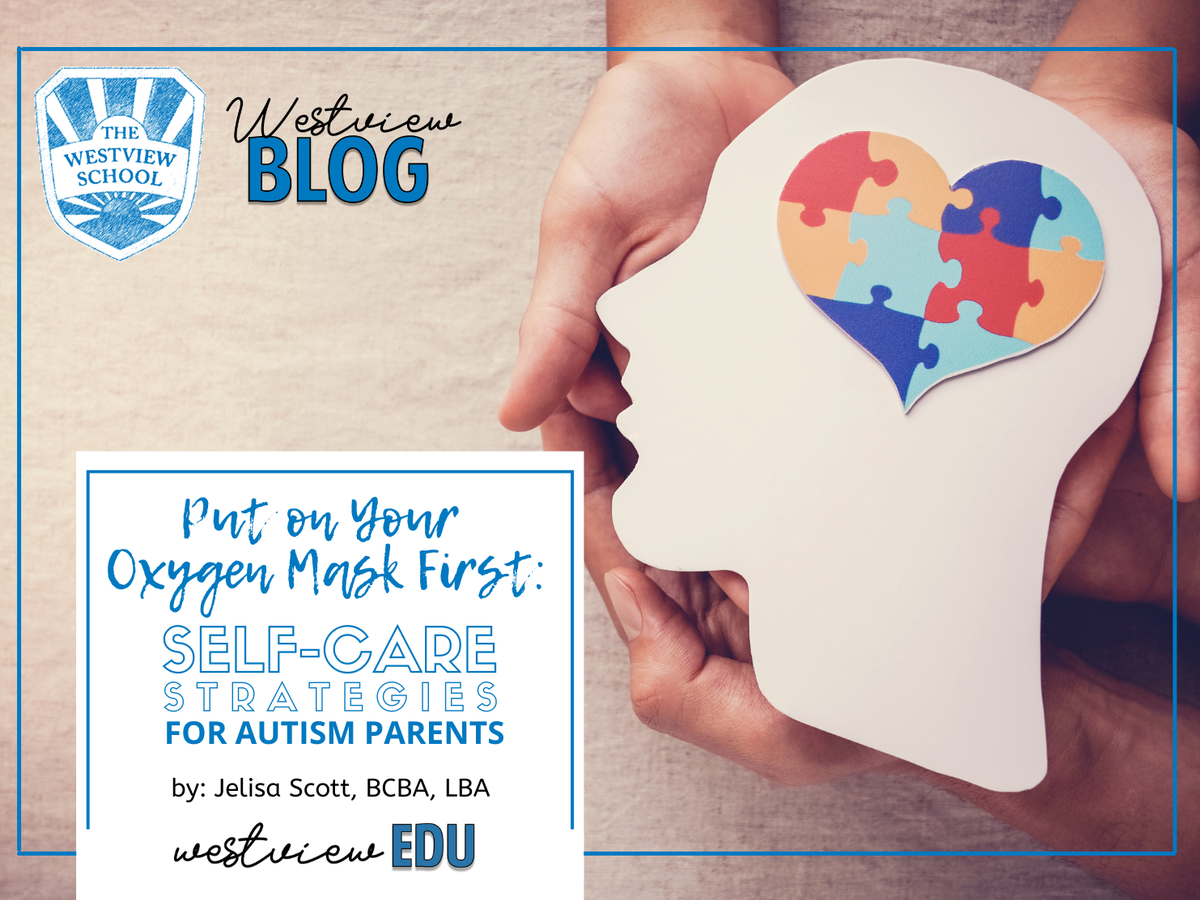
When it comes to parenting a special needs child, there are many things to consider: therapies, schools, medications, the list goes on. However, arguably one of the most essential therapeutic strategies to help your child is evaluating and caring for yourself. To have the physical and emotional energy to fulfill all the duties of a parent (especially an autism parent), you must make sure you are mentally healthy. How many times have we been on an airplane and heard the flight attendant advise, "in case of an emergency, secure YOUR OWN oxygen before helping others next to you." In the case of raising a child with autism, it is essential to "secure your own oxygen" before you can be expected to help your child. Parents who are stressed, feeling anxious about the future, or having depressed feelings about their child's current stage of development, are more likely to have trouble helping and supporting their child in the ways they need. If you really want to help your child, challenge yourself to make these parent coping strategies a habit:
1. Prioritize your self-care.
There's an old adage that says, "empty cups can't pour." Think about the things that fill your cup, and make time to prioritize them. Taking care of yourself is a selfless act because it sets you up to be in the best position possible to continue to advocate and care for your child's needs.
2. Engage with other Autism parents in the community.
You are not alone. Other parents and caregivers of children on the autism spectrum are going through similar situations as you. Expand your social circle to include support from other parents who understand what you experience. Shared experiences help build connections and can decrease feelings of depression, anxiety, and isolation.
3. Minimize anxiety by staying present.
The past is already done, and the future is not promised. Remind yourself to focus on today. When you worry about the future, you miss an opportunity to be grateful for what you have in the now. Be intentional about identifying what you are thankful for right now to help minimize your anxieties about the future.
4. Focus on your child's strengths.
Try not to focus on the negative. It is much more beneficial to focus on your child's strengths. There is no advantage mentally or emotionally to only see your child for the things they can't do. Knowing where your child's strengths lie and keeping them at the forefront can help you use that knowledge to supplement the areas where they need more support.
5. Plan time for fun.
All work and no play does not equal success. Sometimes your child (and you) need a break from it all. Taking time out from the hard work to laugh and play can improve your overall quality of life.
Remember, you are the most important person to your child, and they need you to be physically, emotionally, and mentally strong. Your child needs you to be strong enough to continuously advocate for their acceptance, accommodations, and inclusion within their community. Being strong doesn't mean that you won't have bad days. Improving your well-being doesn't mean that there won't be challenging times, but hopefully, these strategies will help you build healthy self-care habits and, in turn, will help you work better with your child at home.
--
Jelisa Scott is a Board Certified Behavior Analyst (BCBA) and a Licensed Behavior Analyst (LBA) in the state of Texas. She received her bachelor's in Psychology from Louisiana State University in 2010, her master’s degree in Behavior Analysis from the University of Houston Clear Lake in 2014 and is currently in school to earn her doctorate degree in School Psychology from the University of Houston. Jelisa has been working with children with and without special needs since 2008 and has gained experience providing in-home ABA services, parent training, classroom consultations, navigating ARD meetings, decreasing severe problem behavior, improving verbal behavior, social skills training, and early childhood intervention.
This blog post was adapted from the presentation given during WestviewEDU on Thursday, October 7, 2021. WestviewEDU is an education series presented by The Westview School for parents and caregivers of children with autism spectrum disorder. For a full list of WestviewEDU sessions for 2021/2022 academic calendar year, visit The Westview School online.
Memories of Our Mother: A History of The Westview School

To commemorate the fortieth anniversary of The Westview School, the sons of founder, Jane Stewart shared a personal reflection of their early memories of The Westview School and what the legacy of 40 years of Westview means to their family.
A little over forty years ago our mother, Jane Stewart, brought us (Joey, Alan and Steven) all together in the family room and told us she was starting a school for children with disabilities. She had been volunteering at The Briarwood School for a few years and a group of parents came to her and asked if she would consider teaching their children privately. These parents recognized our mother's compassion and love for all children.
Overjoyed that Jane could now offer personal attention and schooling to a population in need of facilities, she turned our “game room” into a school during the day. We have many wonderful memories of coming home from school and watching our mother teaching and caring for her students. Often, we would join our mother rather than playing video games. That time was always very special to us. The parents were ecstatic, and the children made remarkable progress during the time they were with our mother in our home. In fact, one of our mother's first students, whose doctor told her parents she couldn't be helped, years later not only graduated from high school but was also prom queen. Our mother knew that amazing things were in all of us.
After a long discussion, our mother and father, Joel Stewart, decided to purchase a small house on Westview Drive in the Spring Branch area of Houston to expand the school, its facilities, and number of students. The Westview School was born as was the beginning of one of the most successful and ground-breaking schools for children on the autism spectrum in the country. This was a defining moment for our mother, one which filled our family with pride and love. The growth of the school meant so much to her.
As The Westview School evolved, so did our involvement as a family. Alongside our mother was our father, who not only gave his generous support to the school but also brought with him his financial and regulatory acumen. Additionally, throughout high school, we volunteered our summers working various jobs doing maintenance, painting, and building on the school grounds. The most rewarding was when we volunteered as teachers' aids, running with the children on the playground, helping with art projects, singing Heads, Shoulders, Knees, and Toes, and even happily laughing and getting soaked with the students on the slip and slide. These are the types of experiences that are so memorable and special to us.
The expansion of the school to its current location on Kersten Drive was one of the most incredible experiences of our lives. We were honored to have the late Barbara Bush preside over the opening ceremony. She graciously spent time with the students and recognized the importance of the school. This was an experience we will never forget. Most importantly, there would be a much larger school that could accommodate the growing population and could offer even more benefits to the students including a robust multidisciplinary team. Our mother made sure there was a small student-teacher ratio so that the current students received the same personal attention as her first students received in our game room.
The school expanded once again and added another building offering even more opportunities to students. Throughout the forty years, there have been many talented and brilliant individuals who have worked at the school and served on the Board to turn the school into what it is today. We are grateful that the school and staff have committed to the mission of our mom in providing a nurturing and positive environment. The teachers and the entire staff are dedicated and caring individuals. We continue to be impressed by the incredible work and enjoy watching the school and the students thrive.
Throughout our lives, we always felt that our mother was a miracle worker, and it really showed when she worked with children. Her caring, gentle and intelligent approach, based in love for each and every student, showed through at all times.
---
Joey Stewart is a feature film producer and restaurateur that lives in Dallas with his wife Laura, an interior designer.
Alan Stewart is happy to coordinate marketing and VIP programs for music, wine and NFL clients including Duran Duran, Matt & Kim, Westport Rivers Winery, and the Indianapolis Colts. He lives on a farm on the coast of Maine with his wife Lisa who is in the legal field.
Steve Stewart is a physician and Chief Medical Officer of a hospital in New Mexico and lives in Albuquerque with his wife Amy, a lawyer, and their two sons, Wells and Flynn.
Staying Safe at COVID-19 Level 1 in Houston

It seems like déjà vu that we are starting this school year with masks and health screenings again, but we’ve had some noteworthy scientific progress compared to this time last year. Hopefully these changes will make life a little more manageable and get us closer to being done with COVID!
There are so many things we were doing last year that we no longer need to do, since we know more about COVID-19. We don’t need to: wipe down our groceries with Clorox wipes, avoid takeout (no more missing out on Houston’s amazing restaurants!), or hide in our houses 24/7 (although sometimes it’s nice to catch up on Netflix!).
We just need to:
- Get vaccinated against COVID-19 when you’re eligible. When your children are eligible for the vaccine, get them vaccinated as well- currently only children 12 years and older can be vaccinated. Also, plan to get a booster shot when you’re eligible (currently, approximately 8 months after your 2nd dose of Pfizer or Moderna). If you have questions about the vaccines, check out our previous blog post on the topic.
- Maintain physical distance from others. While we have high rates of COVID-19 in Houston, try to stay away from others, even outdoors, and avoid large indoor gatherings.
- Wash your hands often. Soap and water is best, but hand sanitizer is a great option too.
- Wear a mask, especially in indoor space and even if you’re already vaccinated.
- Keep monitoring your personal and your family’s health. Watch for symptoms of COVID-19, even if you’re vaccinated. The most common symptoms of the delta variant COVID-19 are runny nose, sore throat, headache, and fever, which are also allergy symptoms in Houston! Take a COVID-19 test if you are experiencing any signs of illness.
- Maintain your hobbies and your support system. Now, more than ever, we need to keep up our spirits and keep an eye on our mental health.
As a community, we’ve banded together time and time again to face numerous challenges for our children. We know that this is one more trial that the Westview Wildcats are ready to meet. We are strong, flexible, and caring, and we can do this! Hopefully, we can help all of Houston get COVID-19 under control too, so we can truly put this pandemic time behind us for good.
Autism or Teen Drama? Tips to Manage the Teenage Years

The transition between childhood and adolescence can be a confusing and difficult time for children. Things are beginning to change on a mental, physical, emotional, and social level. Autism adds another complicated layer of development to these already challenging times for children. As a parent, you may wonder how you can best support and help your teen navigate these years. It comes with a myriad of questions: Are these behaviors normal? Should it be happening this early? How long will this last? Is this autism or hormones? Should I be concerned about a particular behavior? What can I do about it?
There are a few things to take into consideration. First, parents should determine whether new behaviors are actually due to autism or simply part of typical adolescent behavior. Also, parents need to consider if these changes reflect their teen’s individual personality and preferences. To make things more complicated, it could be a combination of all the above.
Typical Adolescent Behavior
To better distinguish between which behaviors are due to typical adolescent behavior versus autism adolescent behavior, let’s look at what typical adolescent behavior looks like:
- Physical changes include changes in hormones that can lead to new body hair or smells and increases in height and weight.
- Mental changes include developing more abstract thinking skills, using more logic and reason to make decisions, forming their own beliefs, questioning authority, and a heightened focus on physical concerns.
- Emotional changes include shifting moods quickly, feeling more intensely, and increasing risk-taking and impulsive behavior.
- Social changes include experimentation with different levels of social and cultural identity, increase in peer influence, awareness of sexual identity, and learning how to manage relationships.
Most children pass through this period of adolescence with relatively little difficulty despite all these changes. On an even more positive note, youth tend to be quite resilient when problems arise; this includes those with autism. Teens on the autism spectrum often thrive, mature, and increase their competence during this period of growth.
Tips For Parenting Your Teen on the Spectrum
Front Load Information: Our teens on the spectrum learn best when we can front-load them with logical and factual information. We need to be able to prepare them and teach them these life skills ahead of time. The truth is you will not be able to prepare them for everything but showing them the how, why, and what to do can support them through this transition. A simple one to tackle first is why we need to use deodorant or feminine products.
Share Experiences: Teens appreciate first-hand experience, so if you had difficulty navigating through a situation like theirs, then share your experience with them.
Answer Questions: Perseveration on any subject matter is common for children on the autism spectrum. When experiences are novel and uncertain, perseveration can sometimes increase and often cause heightened anxiety. This is not healthy or comfortable for any teen! Answering their questions, no matter how many questions there may be, will be helpful to your child. Also, offering solutions and assisting them in a calm, helpful, and consistent manner will convey that you care and validate their feelings.
Seek Outside Help for Your Child and Yourself: As parents, there is a tendency to tackle it all for your kids. However, during these adolescent years, it may be helpful and even more impactful for your teen to talk about these changes with someone other than you. This could be with a trusted family friend, relative, peer, or professional that the teen feels comfortable answering their questions.
You must also remember that you can build and rely on your support system to help you gain clarity from the fog of dealing with your teen daily. Parenting is hard, and these years with your child can be exhausting! Your community can offer support by letting you vent and sharing personal experiences. You are not alone.
Supporting and learning from each other is key to you and your kid's successful management of the teen years. This is true no matter how old they are. Parenting can be tricky. And life, in general, is not without its share of challenges. When parents and children work together to face changes head-on, we know that these struggles can produce perseverance, and perseverance helps build resilience for both you and your child.
As your child gets older and the teen years approach, it can seem daunting for parents, but as indicated above, there are ways to successfully support and help your teen through this time. If you want to learn more about individual or family therapy, please reach out to The Stewart Center at The Westview School. We are available to support you and your child.
Contact The Stewart Center at 713-973-1830.
--
Mimi Le, M.A., LMFT, LPC is a Licensed Marriage and Family Therapist and a Licensed Professional Counselor. She provides therapy and consultations for adults, parents, siblings, children, families, and groups. She received her Bachelor of Arts Degree in Art History from Baylor University and earned her Master of Arts Degree in Family Therapy from the University of Houston – Clear Lake. She specializes in autism spectrum disorder, trauma- and stressor-related disorders, anxiety disorders, depressive disorders, interpersonal relationships, and multi-generational and cultural matters. She also provides parent-coaching among her other duties as a Student and Staff Support Specialist at The Westview School.
3 No-Nonsense Answers to Common Questions on Special Education
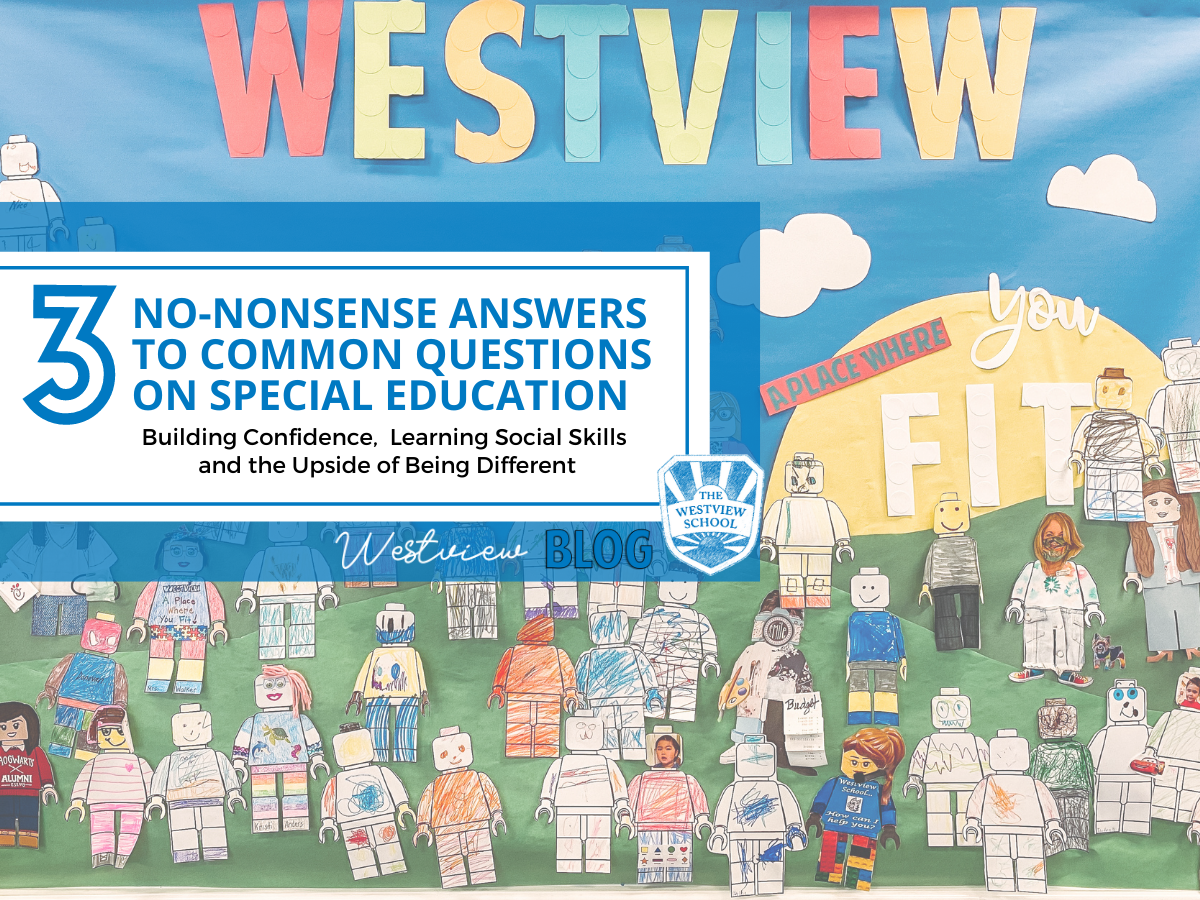
Did you know that tigers have striped skin and not just striped fur?
Did you know that reticulated pythons are longer than green anacondas?
Did you know the formula for the volume of spheres is four-thirds times Pi times radius cubed?
Did you know that honey is actually just bee vomit?
There is a common saying within the autism community, "If you've met one child with autism, you've met one child with autism." Facts and insight collected from various students across various grade levels prove the point that we can always learn something from someone else. Like the students at The Westview School, these little nuggets of information are as different and varied as those who shared them.
With enrollment season upon us, the admissions department of The Westview School is busy fielding questions about the benefits of a private special needs education. Families are looking for the best fit for their children. The Westview School is proud to offer children on the autism spectrum a unique, specialized learning environment with outstanding educational and social opportunities. Some of the obvious benefits of a specialized special needs school include small classroom sizes and curriculum and instruction that is adapted based on each student's need. But there is much more that a school like Westview can provide a child that is not so easily quantified.
We asked our in-house experts, Becky Mattis, M.Ed., Admissions Director for The Westview School, and Mimi Le, M.A., LMFT, LPC, one of Westview’s Student and Staff Support Specialists, to weigh in on commonly asked questions prospective families have when deciding on a program like The Westview School. Their no-nonsense answers to the top three prospective family concerns about a private specialized education are supported by frank, heartfelt, and honest feedback from Westview students in elementary and middle school.
QUESTION 1: Will my child develop self-confidence?
One thing a parent of a child with autism learns very early on is that brains can grow. Developmental pediatricians and neurologists will tell parents, early intervention is the key, that a child's potential cannot be determined until they have an opportunity to learn. Children on the autism spectrum who participate in early intervention therapies and specialized schooling from an early age develop a growth mindset. The concept of a growth mindset was originally taught by Stanford Professor, Carol Dweck. She asserts that facing challenges, working hard, and learning from mistakes develops persistence and results in growth in intelligence and abilities. She further theorizes that people who develop a growth mindset at a young age are confident, resilient, and have a passion for learning. At The Westview School, you will frequently hear a teacher encouraging a student who is struggling with something say, "That's okay, you can try again." Instead of becoming frustrated when they make a mistake, we want our students to quickly regroup and try again.
Becky Mattis: Parents worry about self-esteem for their special needs child. The self-esteem impact that kids have when they are in a place that is meeting their needs, and they are learning and being successful is vastly greater than the negative impact that being in a place where their needs are not met, and they are feeling different and singled out.
Mimi Le: There is a vulnerability [at Westview] that you do not get in a neurotypical school setting. The vulnerability is that I am not the best at this. How can I get better? Both peers and teachers work together to help and encourage you. This may still happen in a neurotypical setting, but at Westview, we are very aware of it, and we make it part of each day, and so do our students.
When a student feels like they can excel at something new, they feel supported in their effort, and in turn, the other students in their class help that too. Students want to learn from the kid that is the expert on trains or the best at math. At Westview, there is never the social expectation to fit into the typical school social norms. There is no judgment. This builds confidence in a child when they are around others that support their expertise in something.
We asked Westview students, “What is your favorite thing about The Westview School?”
Jaden, Middle School: The teachers will go completely out of their way, will do anything they can to see their students succeed. They are always so nice and supportive, and I could not have any better teachers.
Thibault, Upper Elementary: I like this place because it provides a safe place. A safe place from bullies. [Westview] gives me a safe place to learn, and it achieves all its goals in doing so with all its students.
Noah, Middle School: I think The Westview School is a great place to be. The teachers, the classrooms, the fun things we get to do.
Cason, Middle School: My favorite things about The Westview School are the people, the academics. Look around [gesturing down the hallway]; this place looks pretty good.
Ruby, Lower Elementary: My teachers and everybody loves me and PE.
Theo, Lower Elementary: I have lots of friends to play with, and I learn things that I never knew before, and just like Ruby said, I like PE.
QUESTION 2: How will my child learn appropriate social skills without typical peer role models?
Becky Mattis: It is a common question for prospective parents, "Why not just put our child in a mainstream school to learn and observe social skills?" If our children could naturally pick up social and classroom skills from their neurotypical peers, they would easily fit into a mainstream setting. At The Westview School, we get excited when our kids pick up other behaviors because we can then use that as a building block for teaching and guiding our students toward a more appropriate social interaction. By virtue of the population, most of our students struggle with social skills, and because of that, we are intentional in working on the development of social skills throughout the day. The child is not being singled out by being pulled away to talk through those social situations. It is a learning experience for the whole class.
Mimi Le: When children on the autism spectrum are with others who are like them, they are more accepting of individuals with differences. When we put students together in a group or a class, we are looking at where are they are going to fit socially, behaviorally, and academically, so that they can learn something from another student. Where one student may be best at a particular thing, another student can learn from them. Everyone is learning from each other in those three different categories, which helps make them more well-rounded. All kids are different, autism or not. There is always something you can learn from someone else. The thought Westview puts in to placing our students helps to build a respect and appreciation for each other that they would not get in a normal neurotypical setting.
We asked Westview students, “What is something that your friends like about you? What makes you a good friend?
Jaden, Middle School: I am very persistent, and I will do what I can even if it must sacrifice quite a lot to get done what I need to do. I think that me knowing a lot makes me special because I get to teach people what I know, and I find teaching very fun.
Thibault, Upper Elementary: I am passionate, and I strive to work hard almost every single day. I am determined.
Theo, Lower Elementary: I like to run around and exercise a lot and play games. I like to play games on the playground besides tag, because my best friend Sid doesn’t like tag. I like it, but I want to play with him.
QUESTION 3: What if my child knows they are different?
We are all different, and differences should be celebrated, and all children should be taught in a way that most benefits them. In October of 2020, a teacher’s online post on why her neurotypical classroom looks like a special education one went viral. Karen Blacher, who has two children on the autism spectrum herself, found that students benefit greatly when classroom strategies are more focused on encouraging students to openly communicate, and expectations are adapted specifically to that child. Students are taught to both self-advocate and self-regulate.
Becky Mattis: We recognize that all kids are different whether they are on the spectrum or not. Each of our Westview children will discover the ways they learn best and how to then advocate for themselves. Self-advocacy is not only a skill they need for school but in life as well. Being accepting of the things that challenge them.
Mimi Le: Our kids become comfortable with who they are. It is okay to be different. Our kids develop an appreciation for themselves and each other. They are learning that their differences can be something they are proud of, and we foster that in the classrooms and through our conversations with parents. Our students will continue to give the world a new perspective on every aspect of life, and this new lens will lead to breakthroughs in the future.
With cultivating confidence in mind, we asked several Westview students, “What makes you special?”
Cason, Middle School: To be honest, I think I am pretty smart and good at gaming. I am probably the smartest in math. My brain works a little differently than everyone else. It can be good or bad in different ways.
Satvik, Middle School: I am a very tall person, and I am a hardworking boy.
Thibault, Upper Elementary: What makes me special is that I am different from everyone else, and it is like a whole different experience. Without these differences, I wouldn't have gone to Westview in the first place, and my sisters love me literally for who I am.
The Westview School’s mission is to provide a unique, specialized learning environment offering outstanding educational and social opportunities for children on the autism spectrum. We believe that children with autism spectrum disorder can grow and learn through a nurturing, positive, and happy environment that enhances their self-esteem. Building confidence, learning social skills and celebrating our differences is something that The Westview School builds into our daily curriculum.
If you think The Westview School could be a fit for your child, join us for our next Informational Session. The event includes discussions with our Admissions Director, Becky Mattis, about the student experience and program deliverables. Current parents will also be present to offer perspective and answer questions.
The Kids Are Alright: Words of Wisdom from Special Needs Siblings

It has been said that you spend more time with your siblings than anyone else. It is one of the most formative and longest-lasting relationships a person will have. It is estimated that by age 11, siblings have spent more than 33% of their spare time together. When one of those siblings is on the autism spectrum, it is possible that the amount of time together may not differ, but the sibling dynamics certainly could.
Big sisters become little mothers. Big brothers become protectors. Younger siblings learn to be helpers. When a sibling is diagnosed on the autism spectrum, older and younger siblings tag along to therapy appointments and commutes to special schools. They become aware of differences between themselves and their siblings very early on. However, the differences and awareness that come from having a special needs sibling can often positively influence both the neurotypical child and the child with special needs.
Despite the dynamic shift, when children on the autism spectrum have a sibling in the home, it has been shown to positively affect the special needs child. Neurotypical siblings can provide increased opportunities for social skills in the home and serve as role models to siblings with special needs.
But, what about the sibling without a disability? Having a brother or a sister with special needs, in a way, can be pretty similar to having a typically developing sibling. There are the expected challenges among siblings – bickering, rivalry, learning to share, but overall, siblings of children with a disability, including autism, have a great capacity to be highly empathetic, compassionate, tolerant, and responsive to the need of others.
The Westview School blog interviewed several Westview staffers who all arrived in a special education career after growing up with a sibling with special needs. We asked them to share their experiences, how it shaped them as adults, and advice on the positive impact having a sibling with specials needs has had on their life and career in special education. We hope that by sharing their stories of growing up with a special needs sibling, our families may see the positive influences a sibling with special needs can bring to your child’s life.
Caelyn Pho is a Pre-kindergarten teaching assistant at The Westview School. She is the oldest of seven siblings. Caelyn’s youngest sister, Meagan (13), was diagnosed on the autism spectrum at four years old.
“I was twelve when my sister was born,” said Caelyn. “She was not diagnosed early, so I do hold a little bit of guilt, especially since working here. I realized how much more she struggled because of the delay.”
“I come from a very traditional Vietnamese family. Our culture's instinct is to protect,” said Caelyn. “It was more challenging during her younger years before our family learned the skills and strategies to be able to properly deal with her tantrums or other challenges.”
Lexi Doré is a Kindergarten teaching assistant at The Westview School. She is the only sister among four brothers, three older brothers and one younger. The two brothers closest to Lexi’s age are twins, Dalton and Dylan (24), and were born with cerebral palsy. Lexi’s younger brother Bouxdie (11), affectionately called Boux, was diagnosed on the autism spectrum at two years old.
“We got a pretty concrete answer that Boux was on the spectrum when he was two. He wasn’t talking, and he had a lot of food sensitivity.” Lexi remembers the early years of speech therapy and occupational therapy.
Jared Dawkins is the Upper Elementary and Middle School science teacher at The Westview School. He is the middle child of three siblings. His younger brother, Jacob (20), was born with Down Syndrome.
Jared’s experience with special needs started years before his brother was born. “My dad had a cousin, Kevin, with Down Syndrome, so we were very familiar with it already,” Jared said. “From a young age, we were taught that Kevin was different, but he was still part of this family, and we should treat him the same as every other family member.” Jared learned about his brother’s diagnosis before Jacob’s birth. “My mom knew before Jacob was born, and I remember being told that he was going to be like Kevin,” said Jared.
How has having a sibling with special needs positively impacted your life?
Caelyn: I know that Meagan has influenced me and made me more empathetic and compassionate, and understanding to people who do have challenges. Because of my experience with Meagan, I never hesitate to reach out if I see somebody struggling. I never mind helping. Without judgment, there is just a simple, “Oh, you look like you need help.”
Lexi: I have always been an empathetic person with a big heart, but I think that all stems from my special needs siblings. As I’ve grown older, it has become more of a part of me, and it is something I pride myself on, being empathetic towards others. I know how it feels like to be different, and I try my best to accommodate people in how they want to be treated. Because of my experience, I pass that thinking on to my friends and everyone around me. They are just like everyone else.
Jared: Language is a huge issue for my brother, Jacob. He is twenty now, and his language is far less advanced than anyone he communicates with. Communicating with Jacob was learned through sibling dynamics. It comes second nature to our family. This ability to communicate is one skill that has served me well at Westview. Some of our kids seem unapproachable, but I find it very easy to get through to them and understand them.
How did growing up with a sibling with special needs lead you to a career in special education?
Caelyn: My sister is the absolute reason that I started working with this population. If it were not for her, I would not have found my passion, and I will be forever grateful to her. I feel bad for my friends who are miserable at their jobs, and I get to walk in every day, make a huge impact, and love it. That is all thanks to Meagan.
Lexi: I have always had a heart for people with special needs because of my older brothers, but especially when Boux came into my life. I was already volunteering at camps for children with CP. Knowing Boux and how beautiful his mind is and interacting with his classmates on field trips, I wanted to interact with more kids on the spectrum because they are so different, but they are all beautiful and unique. I just wanted to see life through their eyes, and being more hands-on with them is the best opportunity for that.
Jared: After finishing my undergrad degree in English Literature, I enrolled in Texas Teachers to earn my alternative teacher certification. One of the school counselors recommended special education “to boost my resume.” Westview was a perfect fit. I am still learning how to be a teacher, but one thing I didn’t have to learn how to do was learn how to approach and interact with our students. It can be challenging to find people who can interact with our kids in a meaningful and genuine way, and I had that experience already.
What advice would you give to siblings of children with special needs that you have learned from your family’s experience?
Caelyn: There was always a heightened sense of awareness that my sister was different when we were out in public. I was uncomfortable having an audience during an already stressful moment. As a young girl, this would make me angry when I noticed other people minding our business. As I have matured, I have learned to channel that negative energy into help and support for my family and sister. They are what matters.
Lexi: My best advice is, ‘Give yourself the love that you give to others.’ It is important to recognize that it is okay to focus on yourself sometimes, and I am learning this more and more as I get older. You don’t have to feel guilty for taking care of yourself and your needs. Help your sibling. Help your parents as much as you can but be patient with yourself and treat yourself like you treat your siblings.
Jared: It's essential to treat a special needs sibling as normal as possible. It is the only way I know how to interact with people with special needs, be patient and considerate of their particular needs, and treat them as typical as I can. For example, one thing I'll do is if we tell a joke in a family setting, my brother will ask what was said. His language may hinder him from fully understanding the joke in the same way, but just him receiving that information makes him feel like part of the group. In my experience, it's better for me, and my brother enjoys it more when we include him in the game.
What do you love the most about your siblings?
Caelyn: Spoken language can be challenging for Meagan, but she can sing a whole Frozen song without thinking about it. We are a very musically inclined family, so there is lots of singing and dancing for every family get-together, and Meagan is the star of the show. Meagan will start singing along, and she loves to dance. For this reason, she has become one of the pillars of our family just by being there. She reminds all of us to be in the moment. When we get together, we are all pulled in and connected.
Lexi: Boux wins over everyone that he meets. All my friends have this love for Boux. He is just the best person ever. He’s my best friend. Boux is one of the brightest, smartest, coolest people I know. Even though he is not able to convey through words that he loves me, the look on his face, when I walk into a room, I know that I am his best friend too. He teaches all of us that you don’t need words to express how much you love. Love goes beyond words.
Jared: His love for my dogs. I know Jacob loves me. He asks about me when I’m gone, and he likes to hang out with me. I do not doubt how much I mean to him, but my dogs mean more. We have a blast when I come over, and he will want to hang out with me, but if I show up without the dogs, his first question is, ‘where’s Sam?’ I am always second to the dogs.
The Westview School’s mission is to provide a unique, specialized learning environment offering outstanding educational and social opportunities for children on the autism spectrum. We believe that children with autism spectrum disorder can grow and learn through a nurturing, positive, and happy environment that enhances their self-esteem. This is attainable for our students because of the dedication of our faculty and staff. The Westview team is comprised of seventy members, each of whom was led to our special school for varying reasons with a similar underlying theme — a love and passion for the children on the autism spectrum and a willingness to make a difference in the life of a child. For Caelyn, Lexi and Jared, this experience is a bit more personal, and our school is better because we have them as part of our staff.
Reasons To Love Trains: A Mother's Journey with Autism
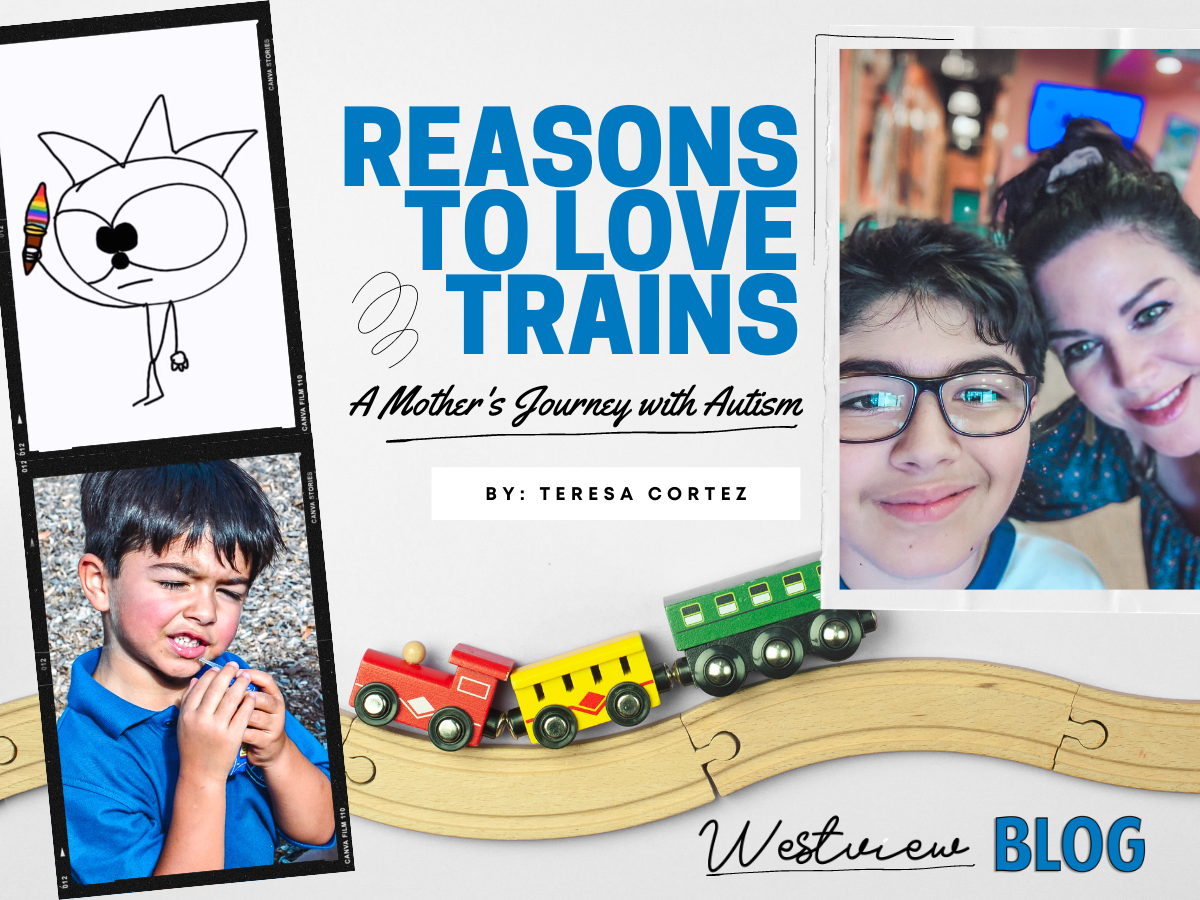
The behavioral therapist who assessed Julian in October 2010 spent two hours alone with him, took into account his developmental delays and inappropriate behaviors: the pushing, spitting, lack of engagement, and severe language delay; the crashing, breaking, food sensitivities, and meltdowns. Once I joined them, the therapist and I talked as Julian played with a vibrating train. He held the train by a thin string for twenty minutes, lifted the train up high, near the left side of his face, and moved only his eyes, shifted them hard left so he could stare at the bright red blur in his periphery. Perhaps he loved the leftward pulling sensation behind his eyes, the string vibrating in his small hand. Maybe it was the change in perspective as he held the train so close he was able to blur the separation between him and the shiny inanimate object.
Near the end of our session, the therapist smoothed the paper on her desk with one hand, looked at me, and said, “I believe Julian is moderately autistic.”
Her word choice struck me immediately. She hadn’t said “mildly” or “severely.” He wasn’t a little or a lot autistic. He was, according to Webster’s College Dictionary, “within reasonable limits…of average or medium quality.” Was there a reasonable level of disability?
“You do?” I asked because I’d hoped for anything but that, and in my denial, had become certain Julian only suffered from apraxia of speech. Now I needed a minute to recover enough to mask my devastation.
“I know this can’t be easy for you,” she said, and I lost my resolve not to cry.
At that moment, the Julian I knew – three years old, flirty, quirky, affectionate, in love with movies, cows, and alphabet letters – was gone. In his place stood a little boy from another planet, a familiar stranger. I’d just handed my former son over to a medical statistic, another 1 in 42 boys.
Almost overnight, a whole new existence formed, a parallel world that looked like earth but wasn’t. It was full of specialists with names like Toshio, Toodie, and Tempa, like Lion, Scarecrow, and Tin Man. It was a sudden ambush of therapies I’d never heard of, long drives, too many forms to fill out, and appointments every week.
I didn’t sleep much. I’d wake in a panic at 2 a.m. and tiptoe into his room to watch my newly foreign child sleep. Grief sometimes took an unusual turn. Though I didn’t notice right away, my husband and I had stopped making videos of Julian and his sister, Victoria. We were still learning what autism was, but we perceived it as a loss, as the erasure of a person we thought we knew well. In essence, this meant one of our children had died, and it felt wrong to record the empty space.
But Julian was very much present; it was his parents who were lost. Still, there was an amorphous loss. Julian wasn’t blind or missing a limb. There was simply no way to truly name or measure what was lost, to label precisely what we were learning to accept. No one could tell me where we’d be in twenty years, what to expect.
If I asked for his name, he told me his age. If I asked his age, he told me his name or launched into a slurred rendition of the alphabet song. At almost four years old, his longest self-composed sentences were two words; he knew about six of these short sentences. His enunciation was awful; therefore, I was one of only a few people who could understand him. He could ask for juice or a toy, but he couldn’t tell me when he was sick, sad, tired, or hurt. He couldn’t tell me he loved me. He couldn’t answer most questions. He didn’t understand words like What, When, Where, How, and especially, Why.
I read countless articles and books about autism, searching for any window into my child, for a cure if one existed. Where were we going with so many hours of therapy, and when would we get there? I asked doctors, teachers, and therapists ten million questions, and still, no one could explain what was lost and whether we’d find it again.
Autism was a social communication disorder with repetitive behaviors, but beyond this general description was a wait-and-see prognosis for every unique child. There was no way to predict what his future would look like. We would have to learn as we went along, accept the trial and error of various therapies, diets, and doctors. His brain was structured differently, not erased. So not only would we need to teach Julian differently, we had to relearn him.
Although he couldn’t use a spoon, hold a pencil, drink from a cup, sit still, or play with other children, I saw a spark, a hint of a brighter light that was, for now, obscured.
Would he ever read? Write? Sit still? Potty-train? Would he be able to work? Was independence the ultimate goal?
Julian had many challenges, but language was especially difficult. Even though his speech became clearer and he began to memorize entire movie scripts, he still struggled to compose his own sentences.
Then he began using movie lines to communicate with us effectively, but still, how could he achieve independence with “movie talk”?
In 2016, I heard about Owen Suskind, a young man with autism who used Disney animated movies to express complex emotions like love and loss. In both the book and documentary film, Life, Animated: A Story of Sidekicks, Heroes, and Autism, his father, Ron Suskind, explained his support of Owen’s Disney obsession by describing why he communicated with his son using puppets and silly character voices, encouraged Owen’s drawing of favorite characters, taught coping skills by applying lessons learned from Disney films to everyday life. He summed up his reasoning with a single sentence, “Whatever works to get to Owen.”
Whatever works to connect…
After learning about Owen, I threw everything I had at Julian’s obsession with movies. I bought the DVDs as soon as they were released, and the small character figurines. I allowed extra time on his iPad, let him watch movies in the car. Soon not only did he tolerate holding a pencil, but he also showed an interest in drawing. So I gave him colorful pencils, crayons, reams and reams of paper. Soon it was evident that he loved drawing, and I noticed that no matter how crudely drawn his characters were, their facial expressions were clearly nuanced. By watching the same movies over and over, he’d taught himself to draw feelings, and all he couldn’t capture in words.
He drew family members and school friends and always included himself as a central character, a protagonist in every adventure. He clearly expressed feelings, motivations, and even abstract thought in pictures. He drew complicated family dynamics, like the day he was born, and inadvertently “replaced” the former “baby of the family,” how that must have made his older brother feel sad. In this instance, he drew the reactions of each family member to fit their individual personalities, which included his oldest sister rolling her eyes at all the birth order drama. This told me he understood complex issues far better than he could convey with words alone. He had empathy, imagination and paid close attention to how people felt and interacted.
Julian once drew a picture of himself as an adult sitting before a computer, working in animation. That was the future he imagined for himself. As The Westview School taught him to read and spell, Julian began drawing “thought bubbles” and writing dialogue. His hand muscles grew stronger, and he developed greater endurance. The kid whose hands were once too weak to hold a spoon or pencil, the kid who hated reading and writing, was now writing books. He plagiarized in the beginning as he copied the drawing style and stories of his favorite author, Mo Willems. Then he inserted different characters, changed up the stories, and made them his own.
He sometimes drew fifty or more pictures in a single day, stacks of pages all over our house. We encouraged him every step of the way, and as much as I hate clutter, I knew we were on to something. So I saved every picture, even the half-drawn pictures, and what might be considered “failed” efforts. My instincts told me we had to attach meaning and value to these drawings, so Julian saw that we respected him and his “work.” His skill and confidence continued to grow.
Now at age fourteen, he’s making stop-action films using Videoshop and Garage Band to create the accompanying music. He’s using more sophisticated animation techniques, making his own music, telling his own stories with both colorful imagery and words. And that initial spark I saw in his eyes? It was creativity and a wicked sense of humor. The kid knows how to entertain.
Throughout these many years of learning to tell his own stories with pictures and words, one thing has never changed: Julian wants us to notice. He wants to show us his creations. He wants to connect. I think that’s what we’re all trying to do in everything we do, connect.
Will he manage to turn these skills into a career? Maybe. But more importantly, he’s proud of himself. He feels a sense of accomplishment. He has confidence and uses art to connect with others. Without his identity as a creative artist, he wouldn’t have as much faith in himself to stand on his own.
A few weeks ago, Julian knocked on my office door, “Can we talk?” He didn’t need anything; he just wanted to sit on the floor in my office and chat. This was new, his wanting to talk about nothing in particular.
I went with it, and suddenly he was asking me what kinds of things I worried about, what life was like for me when I was his age, what kind of kid I was, and was I happy as a grownup? It was evening now, and surely his ADHD medicine had worn off, yet he was so calm, so focused on my responses. He kept asking, and I kept answering, following his lead, our conversation stretching over five, ten, fifteen minutes, uninterrupted. We stayed on track. His thoughts were organized, one after the other, moving along a trajectory that was his alone.
It wasn’t scripted. I didn’t know where this came from, my son, who’s now taller than me wanting to know his mother better, to venture away from his comfort zone of animation to have a real conversation, to connect in a novel way. I felt like I was tiptoeing into his room again at 2 a.m., only now it was to watch him wake up, all on his own. I didn’t want my excitement to get in the way. Because at that moment I was the subject of interest, he held up close, seeking a new perspective, blurring the separation between us.
--
Teresa Cortez has been a Westview parent since January of 2011. She’s a mother of four and resides in Richmond, Texas.
The Experts' Guide to Picky Eaters

Are mealtimes a battle? Does your child have a limited food repertoire or only eat one brand of food? Desperately seeking tips for a successful family mealtime? The Stewart Center has some Picky Eater experts on staff to share their favorite tips and best practices from hands-on experience working with some of the pickiest eaters and their families.
The first question many families ask is: Who can help? Eating is a multisensory experience. As adults, we forget the many factors involved in eating because it is such a routine task for most of us, but eating is a surprisingly complex process. Both speech and occupational therapists can play an essential role in supporting positive change in even the pickiest of eaters.
Abby Cook, M.S. OTR, and Alexandra (Ali) Nevins, M.S., CCC-SLP are part of The Westview School's Stewart Center team and are trained in the S.O.S. Approach to Feeding®. This approach is a sensory-based feeding intervention that moves students through a hierarchy of exercises designed to increase tolerance of various foods. The S.O.S. Approach to Feeding® was developed by Dr. Kay Toomey over 30 years ago. Her program has a high success rate in the diversification of diets of picky eaters.
Because eating uses every sensory system, from visual and tactile to vestibular and interoception, a multisensory approach to feeding therapy is the start to a recipe for success. Pun intended. The Stewart Center therapists are trained in evaluation and assessments and the facilitation of individual and group feeding therapy.
When it comes to feeding therapy, a speech therapist, like Ms. Ali, can assess and support the development of a child's oral motor and feeding skills, mechanisms of chewing and swallowing, oral motor structure as well as protecting the airway during the swallow, biting, and chewing phases of eating.
An occupational therapist (OT), like Ms. Abby, can help to develop a child's fine motor skills and coordination needed to move food from plate or hand-to-mouth. Skills such as grasping, utensil use, postural control, and musculoskeletal strength for positioning during eating are necessary for successful feeding. An O.T. can also observe and assess environmental factors, modify or make changes to support optimal focus and attention to eating. Both speech and occupational therapists will consider all of these factors when working with children with food aversions to identify how to best help an individual child.
Today, we want to offer some quick tips that you can implement at home now. When dealing with a picky eater, it is essential to examine three things – the environment, language, and behaviors we model. Start with a quick check by asking yourself these questions:
- Is there a smell or taste that is overwhelming or underwhelming to your child?
- Is the environment overstimulating?
- Is there background noise during mealtimes, such as television or music?
- Does your child have the opportunity to watch a sibling or parent eat and model typical feeding behaviors?
- Can your child manipulate a utensil successfully?
- Do you find yourself saying two more bites, and then you can go (i.e., play, watch tv, or play the IPad).
Try these tips to skip those mealtime battles and help your kiddo expand their palate and self-feeding skills.
Set Up for Success: Check Your ENVIRONMENT
- Seating tops the list of important environmental factors for a successful mealtime. Think 90-90-90. Hips, knees, and elbows should be at 90-degree angles while seated for eating. Stick to a sturdy chair or highchair at the table.
- Provide appropriately sized utensils at mealtime, and use fun phrases to initiate utensil use during mealtime like "Catch the food on the fork."
- Keep food portions small – especially with new foods. The new color, smell, or texture may be overwhelming! Always provide at least one familiar food item for your child to eat. Make sure to have some new options to try exploring, but a safe food should be just that - one that feels "safe."
- Keep regular mealtime routines to lower stress and keep expectations clear for everyone.
- Have your child throw away their uneaten food items in the trash. This gets them one step closer to interacting with food, even if it is to throw it away.
- Limit both visual and audible distractions during mealtime. Television, music, and iPad can detract from your child's ability to observe typical eating and self-feeding.
- Model it! Eat meals together as much as possible. Children need to see visual models of typical eating behaviors.
Hungry for LANGUAGE. While your focus may be on what should be going in your child's mouth, what comes out of yours matters just as much.
It might be time to flip the script if you have said one of the following to your picky eater: "Clean your plate." "You have to take two bites to leave the table." "Good job eating that." "Finish your food before (i.e., T.V. or Dessert)." These phrases can unwittingly up the anxiety during mealtime.
Instead, use some alternate words/phrases that keep mealtime stress-free and fun.
- In response to, "I'm not going to eat that!" ask, "What can you do with the cheese stick?" It helps to give an example: "Can you make a mustache or wiggle it like a wobbly worm?"
- "What can you catch on your fork?"
- "Does that food have a big flavor?"
-Encourage your child to say, "I'm still learning about that." instead of "I don't like that!"
Your mother may have said, "Don't play with your food!" but when it comes to a picky eater, it might be time to change your BEHAVIOR around eating.
- Model eating and be PLAYFUL! Make food fun! Make it ok to "play" with your food. Parents can model food interactions that go beyond simply eating; encourage play during mealtime. Some examples of play can include: placing food on body parts, making a noodle into a worm, using crackers to build a sandwich, digging for gems in jello or pudding, and using food as a mustache or a long tongue.
- Avoid forcing your child to take a bite or a drink of something. This sets up an unwinnable power struggle.
- Avoid tricking your child with foods or beverages. As therapists and parents, we need to build and maintain a child's trust-related to food and drinks. When we "sneak" a new vegetable or drink into a familiar dish or a preferred cup, it can disrupt trust and turn a child off from a preferred food altogether.
We hope that these tips help you gain confidence and avoid some pitfalls at mealtime with your picky eater. If you want to learn more about Individual or Group Feeding therapy, please reach out to The Stewart Center. Our team is passionate about working with our picky eaters, supporting their families, and having fun with food.
If you are interested in learning more, contact The Stewart Center at 713-973-1830.
Additional Resources:
Instagram:
@kids.eat.in.color
@sosapproachtofeeding
@solidstarts
Websites and free resources:
sosapproachtofeeding.com/start-here-parents/
www.solidstarts.com
Parent & Caregiver Workshop (Free Full parent workshop video)
Learn from Dr. Toomey (the founder of the SOS Approach to Feeding) about why children don’t eat well and practical strategies for improving mealtimes in your home through the introductory video “When Children Won’t Eat (and how to help!).
--
Alexandra (Ali) Nevins, M.S., CCC-SLP is a Licensed Speech-Language Pathologist with the Texas Department of Licensing and Regulation and obtained a Certificate of Clinical Competence through the American Speech-Language-Hearing Association. Ali completed her Bachelor of Applied Science Degree from The University of Mississippi and received a Masters of Science in 2018 from Yeshiva University at The Katz School. In New York City, Ali worked as a clinical extern in the school system as well as at New York Neurogenic Speech-Language Pathology, P.C. Ali has been working full-time as an SLP at The Stewart Center at The Westview School since 2018. She has received continuing education training in SOS Approach to Feeding ® and Social Thinking ®.
Abby Cook, M.S., OTR is a Licensed Occupational Therapist with the Texas Board of Occupational Therapy Examiners and obtained certification through the National Board for Certification in Occupational Therapy. Abby completed her Bachelor of Arts degree in Psychology and Family Studies at St. Olaf College in Minnesota, and received a Master’s of Science in Occupational Therapy from the University of New England in Portland, Maine in 2017. Once in the Houston area, Abby started her OT career in Early Childhood Intervention for Brazoria County and has been full-time with the Stewart Center at The Westview School since 2018. Her continuing education training includes SOS Approach to Feeding ® and introductory coursework in The DIR/Floortime Approach®.
Key Ingredients to a Successful Early Childhood Development Program
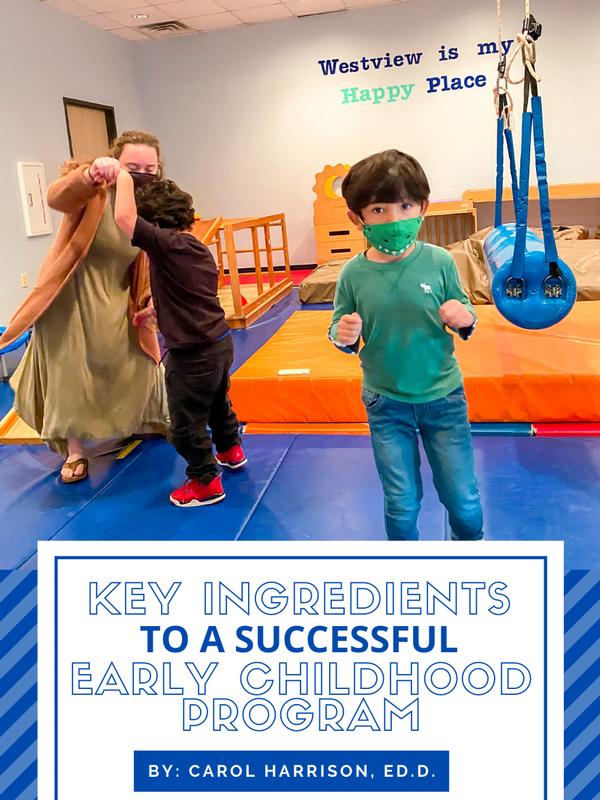
When Grayson Garcia first walked into The Westview School at the age of three, his parents would have described him as grumpy, agitated, easily upset, and angry all the time. He had minimal language, and outside of his parents and brothers, he did not connect well with others. A lengthy evaluation process and an autism spectrum disorder (ASD) diagnosis led the Garcia family to The Westview School. After a tour of the campus, the Garcias had hope that Westview would be a fit for their son.
Joni Garcia, Grayson's mom, remembers the day she brought Grayson in for a visit in the Early Childhood Development (ECD) class. "Grayson took two steps into the lobby and stopped," Joni recalled. "He looked at me, and then down the long hallway, and then over to the reception desk where Ms. Candi sat. Grayson threw himself on the floor and began to scream and cry."
At Grayson's initial reaction to the visit, Joni felt her hope start to fade, but what happened next is just one reason why Westview is an answer to so many children and families.
"Ms. Candi stepped out from behind her desk, grabbed a wagon parked in the hallway, rolled it over to Grayson, and with ZERO emotion said, 'well, if you wanted to ride in the wagon Grayson, all you had to do is say so.' Grayson immediately stopped crying and just stared at her, and then without a word, hopped in her wagon and was rolled down the hallway."
That interaction began three years of a nurturing and supportive education at the Westview School that prepared Grayson to transition to a special education program in a public school and eventually into a mainstream general education class.
So, what is it about The Westview School that helped Grayson become a mainstream success story? When it comes to early intervention for ASD children, what are the key ingredients for a successful Early Childhood Education Program that families should look for?
1. A strong early childhood program will have teachers and staff with experience and training in connecting with children with ASD. Traditional daycare programs are loving, safe environments that ensure basic needs such as feeding and changing are met, but many times the teachers don't have the training or experience to know how to connect with children with ASD. Joni realized on her first day at The Westview School that it was less about Grayson connecting but more about someone else being able to connect with him and speak his language.
2. A low student to teacher ratio ensures that each child gets the individual attention and support they need. Limiting class sizes to a maximum of five students with a teacher and assistant ensure fewer distractions and more opportunities for student participation in lessons. Also, smaller groups allow teachers to differentiate instruction, engage with each student, and better facilitate student to student interaction.
3. Effective ECD teaching should be based on research-based methodologies and strategies. Young children with ASD need a program designed to develop self-regulation, attending skills, and joint attention. Strategies for Teaching based on Autism Research (the STAR program) is a research-validated program that includes guided lesson plans, teaching materials, data systems, and a curriculum-based assessment in six curricular areas.
The STAR Program uses curriculum-based assessments to identify performance levels for each student, based on a scope and sequence of developmentally appropriate skills. Assessments are used to track and report student progress and identify instructional skills to be targeted for instruction. Children are engaged in high-interest, thematic units. As students learn how to self-regulate and attend, they are ready to work on pre-academic skills such as letter and number recognition, one-to-one correspondence, sorting, colors, shapes, and basic math vocabulary.
4. The development of communication skills is a core component of a strong ECD program. Emphasis is placed on expanding and contextualizing language within social interactions. Both expressive language abilities (labeling, describing, and comparing/contrasting) and receptive language abilities (identifying, matching, and sorting) are a focus of effective early childhood programs. Skilled teachers use a variety of structured activities to encourage and elicit spoken language. With a scaffolded approach to language acquisition, children learn to follow directions, complete tasks, and work in small groups within their environment.
5. Teacher facilitated social interaction is essential in ECD classrooms. In the most effective classrooms, teachers devise developmentally appropriate play situations to teach students how to play and interact with others. Peer relationships and appropriate social skills are acquired through guided play and interactive group games and activities. Students engage in various teacher-facilitated activities, such as pretend play, storytelling, role-playing, social routines (birthday parties, Halloween, etc.), and floor play to encourage group participation and interaction. Focus is directed toward exposing children to experiences that lead to a greater understanding of social expectations.
6. A focus on fostering self-help and independence should be a part of any strong ECD program. Self-help skills such as eating/drinking, dressing, and cleaning up play areas are intentionally incorporated into the daily schedule. Toilet training may be part of the daily routine. Children should be given the opportunity to make choices throughout the day and encouraged to become more independent. Using visual schedules helps students become more independent during transitions, restroom time, and other daily skills and activities.
Over two decades of autism research have shown that early diagnosis of autism spectrum disorder (ASD) combined with the prompt, evidence-based, and effective intervention will result in the best possible prognosis for children with ASD.
Research also indicates that in an appropriate educational setting, early intervention for at least two years before the start of primary school can result in significant improvements in language acquisition, motor development, academic achievement, social skills, daily living skills and also promotes independence in children.
Grayson is now in third grade. According to his parents, he is thriving in a general education classroom with 22 other typical kids. Grayson still has autism, but his diagnosis does not define him because of his success in the Westview School's early education.
Accepting students as early as 24 months, the Westview School proudly offers a high-quality early childhood program using research-based methodologies and strategies. If you would like to learn more about our early childhood program at The Westview School, visit our website or contact Carol Harrison, Ed.D.
If you think The Westview School could be a fit for your child, join us for our next Informational Session. The event includes discussions with our Admissions Director, Becky Mattis, about the student experience and program deliverables. Current parents will also be present to offer perspective and answer questions.
Register Here
--
Dr. Harrison brings a wealth of knowledge and experience to The Westview School following an extensive career as an educator and administrator. She served as an elementary school principal and special education administrator for 25 years in the public school system and later taught as a professor at Stephen F. Austin University. She holds a Doctorate in education.
8 Reasons to Try Art Therapy

Why Art Therapy for Autism Spectrum Disorder?
Art Therapy offers the opportunity to learn and practice many social and emotional awareness skills that are a struggle for children on the Autism Spectrum. Self-expression and maintaining and developing relationships are explored and enhanced through both the therapeutic relationship and art therapy. This is because the relationship established between a client and the therapist can promote healthy and safe attachments. The art-making component builds on that relationship and offers an alternative form of communication, sensory integration, self-expression, and promotes cognitive-emotional development.
8 Reasons to Try Art Therapy for Your Child with Autism Spectrum Disorder:
1. Imagination/Abstract Thinking
Art therapy can help your child display age-appropriate imagination and abstract thinking skills.
2. Sensory Regulation & Integration
Art therapy can improve your child's ability to regulate his or her body and integrate sensory experiences.
3. Emotions/self-expression
Children learn to use art to externalize and process thoughts and feelings, improving communication and connection between children and their caregivers.
4. Developmental Growth
Art therapy helps children hit important milestones like age-appropriate drawing ability, fine motor skills, overall artistic development, and can be used to improve other relevant deficit areas that can be addressed using art.
5. Visual-Spatial Skills
Art therapy improves the child's ability to negotiate and render/model in both two and three-dimensional spaces and the ability to rotate objects mentally.
6. Recreation/Leisure Skills
Art therapy helps children on the spectrum develop productive, enjoyable leisure activities and generalize them to the home and other natural environments.
7. Developing Self-identity/Empowerment
Using art-making can help children explore, learn, and discuss the different components of an Autism Spectrum Disorder diagnosis that empowers them to build a positive self-identity.
8. Reduce Anxiety/Stress
Art therapy also promotes learning coping skills through the creative process, including mindfulness, deep breathing, and guided imagery to improve emotional self-regulation.
How to Tell if Art Therapy is a Good Fit for Your Child:
• Does your child struggle with self-expression, relationship building, emotional regulation, abstract thinking, sensory processing deficits, or communication?
• Is your child interested in creative processes?
• As a parent, are you willing to actively participate in your child's therapeutic treatment while respecting therapeutic boundaries?
If you answered yes to the questions above, your child might benefit from art therapy.
Individual Art Therapy sessions are tailored to your child's needs. The child will lead the therapist to what materials naturally pique their interest. From there, the art therapist will create a treatment plan that includes goals and objectives. You, as the parents or caregivers, will be included as active participants in the therapeutic process.
Group Art Therapy sessions are based on a common goal. All group members will be screened to ensure they are an appropriate fit, and members will be placed according to similar developmental and emotional needs. There is a significant social and communication component to every group that children on the spectrum can benefit from. Because many individuals diagnosed with ASD are visual thinkers, artwork can facilitate forming connections with peers because it offers a concrete way to see another's perspective.
To learn more about Art Therapy at The Stewart Center, visit our website and connect with Hillery Jones.
--
Hillery Jones is a Licensed Professional Counselor and Art Therapist. Her passion is in using the creative process to help children, adolescents, and adults gain a deeper sense of self-awareness. Her approach is client-led, practical, holistic, and adaptable in everyday life. She integrates a kinesthetic learning component of connecting mind and body to her practice. She uses traditional talk therapy and art therapy to meet the unique needs of each individual. Her ultimate goal is to provide clients with the tools needed to be the best version of themselves.
Hillery received her B.A. in Art Education from Lamar University and her M.A. Art Therapy Counseling from Southern Illinois University, Edwardsville. She has worked in school, hospital, residential, and out-patient settings.
Tried & True Tips for Keeping Your Family Healthy this Fall

Temperatures are dipping below 90◦F and the smell of pumpkin spice is in the air. Fall has arrived in Houston! As we move into another season of 2020, we have learned to be flexible, anticipate the unexpected, and go with the flow. That said, there are several reasonable ways in which we can consistently support our families’ and communities’ health.
Tried and true methods to stay healthy:
-Wearing a mask, washing hands, and social distancing, as Covid-19 is still a concern.
-Eating a healthy and varied diet to ensure that we are getting the nutrients that we need and that our kids are getting the nutrients they need too.
-Exercising regularly and encouraging physical fitness for the whole family.
-Getting enough sleep, as well as getting good quality sleep with healthy sleep hygiene.
-Keeping up to date with doctors’ appointments (including check-ups), dentist visits, therapy sessions, and flu shots. As we move into flu season and as we are seeing another uptick in Covid-19 cases, our communities must try to keep the hospitals from getting overwhelmed again. This means we all need to keep from getting Covid-19 and the flu (there’s a flu shot for that!).
-Staying home if you aren’t feeling well, and getting tested for Covid-19 if you are showing any possible symptoms. This epidemiologist tried out the free test at Minute Maid Park- Lot C and was impressed. It was an oral swab, rather than nasal swab, and the PCR results were in my email within 46 hours.
New and novel ways to support good health:
-Supporting your family’s mental health through mindfulness. Stress has been a constant factor, especially lately, and mindfulness methods can be helpful in providing relief.
-Maintaining relationships with your social circles, even while maintaining physical distance. As a community, we have really gotten creative in the many ways we can stay in touch. Weekly Zoom get togethers, drive-by birthday parties, sending cards in the mail, and taking classes online together are some fun ways to keep up with loved ones. Consider creating a social bubble with another family whose Covid-19 exposure level is similar to yours; commit to only spending social time with each other and maintain strict social distancing with all others.
-Creating new traditions for holidays and special times. Halloween is a great time to “boo” your friends by dropping off treat baskets on their doors. Thanksgiving could be a multi-state event with families sitting together online to eat dinner at the same time and even playing games like bingo together! Cookie exchanges can easily become online events, and you can even include long-distance friends!
-Reaching out to give and receive support. One of the silver linings of the pandemic has been watching people standing up to support one another. Whether saying a kind word, smiling eyes behind a mask, or showing gratitude for the “helpers,” we have shown the strength and resilience of the human spirit.
As we move into the end of the year, look back and see how far we have come in 2020. Our children are thriving and doing well in so many unexpected areas, and our communities continue to stand together through thick and thin. Hang in there and enjoy the cooler temperatures- we’ll see you outside!
Wishing you strength and good health,
The Westview School COVID-19 Medical Advisory Committee
--
The Westview School COVID-19 Medical Advisory Board is comprised of Westview parents and former parents with experience on the front line during this pandemic. These highly-trained professionals work in many different fields of medicine, such as epidemiology, pulmonology, and critical care. This group of medical professionals continues to be an invaluable resource to The Westview School leadership team.
The One Thing I Want You to Know about My Son on the Autism Spectrum
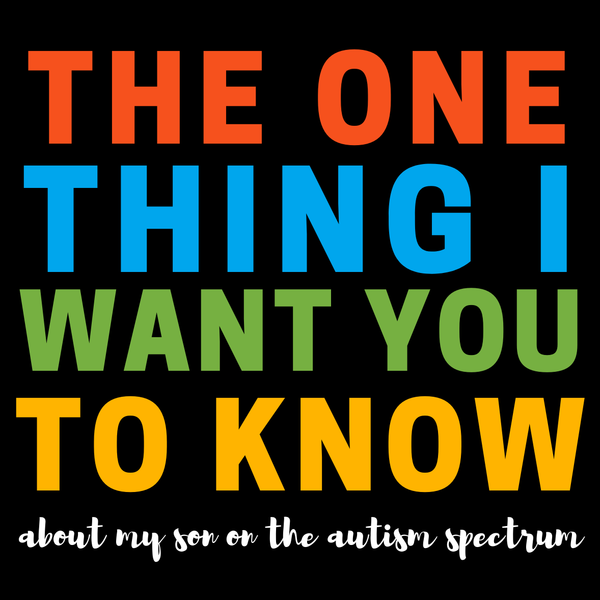
Have you heard the saying, “If you’ve met one child with autism, you’ve met one child with autism?” It is called a spectrum for a reason, and under the umbrella of autism spectrum disorder, you will find a vast differentiation of children and behaviors.
My son, Noah, is 12. As a parent, I am way past the point of explaining or apologizing for his differences in behaviors and communication. He is an awesome kid. As his mom, I know exactly how much time and effort and money our family has invested into growing Noah into the best version of himself. From therapy to special schooling, medications and doctor’s visits, we have ten-plus years invested. For all his weaknesses, his strengths are many, and I can honestly say that I know how hard we have worked to hone those strengths. It is still a work in progress and probably will forever be.
This started as an article about 10 things I want you to know about my child with ASD. But, really there’s only one thing I want you to know: WE NEED GRACE.
Grace has many definitions, but let’s go with this one: “The disposition to or an act or instance of kindness, courtesy or clemency.” There’s a lot of talk about Autism Awareness. We even have a month for it in April as a reminder. But, what do you do in the face of someone who is different, and how will you teach your children to react to those differences?
There was time somewhere between his diagnosis at 24 months and now that I was more sensitive and less accepting of what I perceived as a deficit in my child. Was I doing enough? Was I doing the right things? Is everyone looking at us?
One moment always comes to mind. Noah was about 6 years old. He has always been high energy with difficulties in body regulation. Translation: he’s super hyper out in public. It’s funny because he’s pretty logical, and he has a good moral compass of right and wrong. He knows how he should act in particular situations but somewhere between thinking and doing, things tend to go awry. We happened to be heading into his favorite store - Target. Before getting out of the car, I gave him a little pep talk. I call it front-loading, where I prepare him for what is about to happen next.
Me: “OK, buddy. Here’s the thing. We are about to go into Target, and I want you to have a super quiet body.”
Noah, with complete confidence in himself: “Got it, Mom.”
But, as much as I tried to front-load, and as much as Noah thought he had this, walking into Target, the excitement of a favorite place couldn’t keep his little body calm. He was immediately jumpy and chatty earning stares from the other shoppers. So, there I stood on the toy aisle, giving up the fight of keeping him quiet. I was letting him live his best Target life by bouncing up and down the aisles.
Another mom walked up to me. She said, gesturing toward Noah “is he… (awkward pause and whisper) autistic?”
I nodded.
She continued. “Have you tried therapy? Or diet? I have this friend…”
You could ask any autistic mom to fill in the blanks here. We’ve all been in this sort of a situation. And, man… it totally stings.
“Did you vaccinate?”
“Have you tried ABA?”
“Is he gluten free/casein free?”
“Have you seen Parenthood?”
She must have caught me at a weak moment because all I could think as I started to tear up was Noah was eight, and we had been in therapy and special schooling for six years. And, I was working so hard for him. He was working so hard. And, it just took one misplaced comment from a well-meaning fellow mom to bring up all the insecurities that in my heart said, “Are we doing enough? And is it all my fault?”
I always wonder how that particular situation could have gone differently, and why it has always stuck with me. Maybe just a “Good job, Mama!” would have sufficed. Maybe Noah isn’t something that needs fixing. As a parent, we are always trying to challenge and improve our children, neurotypical or not. That’s why it’s called “raising” kids. We are all just working on different things. And, I am so proud of my child, and he’s got so much to offer to our family and this world. He’s smart and kind. He loves his sister and pizza. He’s the fastest drawer I know, and his favorite color is red because it comes first… duh. He can pick out all the countries of the world based on size and shape, and he is an avid collector of graphic novels. And, one of the things, I am trying to teach him is showing love and acceptance to the people around him. Need something to work on with your kiddo too? It’s a good one. Take time to say, “Thank you.” Take an interest in the people around you even the ones who are different. Practice simple acts of kindness. Raising tiny humans is hard - autism or not.
And, I think the best we can do is show a little love and give a little grace and teach our children to do the same.
When it's More than "Picky Eating"

Many parents have children who are picky about the foods they eat. However, some children seem to take this selectivity to an unusual or extreme level. When this happens, parents can become desperate and resort to strategies or techniques that they would never consider for other issues. Stockpiling fast food cheeseburgers or making multiple trips to the grocery store just to ensure that the “right” chicken nuggets are available may not be a parent’s ideal response to a picky eater, but many families have had to use these strategies just to keep their children eating.
"If you have a picky eater, it is likely that you have had at least one person say, 'If she gets hungry enough, she’ll eat!' The truth is that this 'traditional wisdom' that kids will eventually eat what is provided or repeatedly presenting the same food until the child eats it does not work for all children."
If you have a picky eater, it is likely that you have had at least one person say, “If she gets hungry enough, she’ll eat!” The truth is that this “traditional wisdom” that kids will eventually eat what is provided or repeatedly presenting the same food until the child eats it does not work for all children. This appears to be especially true for children with intense sensory needs, like those that often occur alongside autism. These families often feel trapped by their child’s picky eating, limiting the places they go or even the family trips they take due to concerns over whether they will be able to get their child to eat and/or the behavior they might use when their preferred foods are not available. When good, old-fashioned consequences, rewards, and bribery are ineffective at expanding a child’s food repertoire, specific intervention may be necessary.
What can you do to help expand your child’s palate? Many families find relief in sensory-based feeding intervention, such as the S.O.S. Approach to Feeding®. This approach draws on the expertise of psychologists, speech-language pathologists, occupational therapists, dieticians, and the medical community to provide an intervention that is Sequential, sensitive to the Oral-motor needs of each child and addresses the Sensory needs that are likely involved in a self-restricted diet. Typically implemented in a group setting, the S.O.S. Approach to Feeding® aims to change the ways that children learn to explore new foods by integrating play and positive experiences with the introduction of new foods. The Stewart Center is fortunate to have two professionals trained in this approach and offers groups for different ages, as well as individual sessions, if needed.
The holiday season provides a particularly challenging set of social expectations, especially when it comes to food and eating. Children are often asked to eat (or at least tolerate) foods that are unfamiliar to them. Loud and embarrassing refusals can ensue, leading to hurt feelings and even family conflict. Teaching children more socially acceptable ways to decline non-preferred foods is a good first step toward navigating these tricky situations. For example, in our “Picky Eaters” group, children are taught that brains need lots of information before making a decision, and that we avoid saying “I don’t like that” until our brains have collected enough of this information. Instead, we say “I’m still learning about that.” Not only is this less offensive to whomever prepared the food, but it also opens the door for playful interactions with the food as we continue to gather our important information.
However your family copes, we want everyone to know that picky eaters do not have to dictate your family’s choices, and that there are more options than simply accepting your new, limited experience.
If you would like to learn more, The Stewart Center offers family consultations, group or individual therapy sessions, or even just help troubleshooting or brainstorming. Call 713-973-1842 to find out more.

I am proud to be part of your teacher (music) community from 2002 through 2018.
Jane was an inspiration to each and every teacher at WESTVIEW!